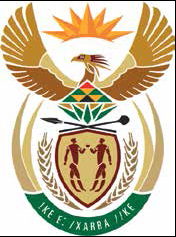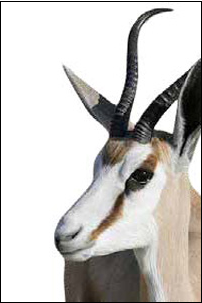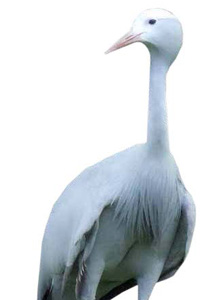Apr 2014
Apr 2014 sadmin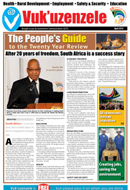
After 20 years of freedom, South Africa is a success story
After 20 years of freedom, South Africa is a success story sadminSouth Africa is a success story and a better place to live in compared to 20 years ago.
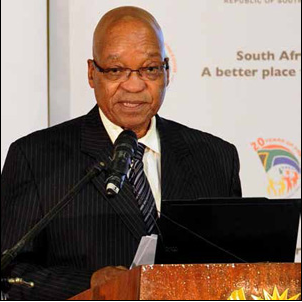 And according to President Jacob Zuma, people from all walks of life contributed to the good story South Africa has to tell.
And according to President Jacob Zuma, people from all walks of life contributed to the good story South Africa has to tell.
The transition from apartheid to a democratic South Africa was because of partnerships between government, civil society, business and labour, said the President at the launch of the Twenty Year Review.
The review looks at how the country has progressed since democracy in 1994.
“We humbly thank South Africans from all walks of life for their contribution to the successes that our country has scored.
“We have succeeded because of the hard work of all our people who contributed in various ways to rebuilding their country. We are honoured to place before the country this Twenty Year Review, which provides evidence in this regard,” said President Zuma. According to the review, the country has made significant progress in a number of areas including education, safety and security, fighting poverty, housing and access to health care.
Education
The President noted that more than eight million children now benefit from the no-fee policy, which sees some schools not charging school fees, resulting in an increase in secondary school enrolment - from 51 per cent in 1994 to about 80 per cent currently.
About nine million school children also benefit from the school feeding scheme, which ensures that learners no longer have to study on an empty stomach, and in the past five years alone, 370 modern schools have been built.
Access to higher education has also increased over the past 20 years.
“University enrolment has almost doubled since 1994. There have also been huge increases in enrolments at further education and training (FET) colleges, following an intensive focus on these colleges in the past five years,” he said.
Health
President Zuma said South Africans could be pleased with developments in health care.
“In addition to free basic health care, more than 1 500 health care facilities have been built and existing ones have been revitalised over the past 20 years,” he noted.
South Africa’s response to HIV and AIDS has also been praised internationally.
Economic progress
In 1994, the new government inherited an ailing economy that excluded the black majority. Despite these challenges, the economy has grown at a rate of 3.2 per cent over the past 20 years and has become more representative.
“Positions of power in the economy have become more representative since 1994, encouraged by government’s black economic empowerment and affirmative action policies.
“These policies will continue until the structural characteristics of apartheid in terms of inequality in ownership, management and control of the economy, as well as pay, have been addressed,” he added.
Land redistribution
According to President Zuma, almost 250 000 people have benefited from government’s Land Redistribution Programme.
“Government introduced the Land Redistribution Programme in 1994. Since then, government has redistributed 9.4 million hectares of land, benefiting almost a quarter of a million people. The target had been 30 per cent of the agricultural land owned by white South Africans.
“As the review indicates, only 24 per cent of black households are involved in agriculture and very few commercial farms are owned by black people.”
He added that soon the country would know the status of land ownership.
“A land audit has been completed, which will assist to identify further land for reform purposes.”
Infrastructure
Since the mid-2000s, government has also focused on economic infrastructure such as ports, rail, dams and power stations. Over the past five years, investment in infrastructure has dramatically increased.
“Investments in infrastructure will increase further, including on much needed social infrastructure such as water, electricity, sanitation, schools, colleges and housing, amongst others.”
President Zuma also noted that municipalities have made progress in delivering basic services.
“It is impressive that a number of municipalities which had little or no pre-existing institutional foundations, have been able to deliver basic services to thousands of people who did not have them before in the past two decades.”
He said the focus was now on reaching communities that were still waiting for services, particularly in informal settlements in urban areas and in remote rural areas.
Safety and security
“Crime levels remain high, particularly President Jacob Zuma praised South Africans for their contribution in making South Africa a better place than it was in 1994 when he released the Twenty Year Review recently. to the Twenty Year Review crime against vulnerable groups such as women and children which require continued intensive focus,” explained the President.
He said despite the challenges that remain, South Africa has a lot to be proud of.
“Given the manner in which we were able to pull our country back from the brink of disaster, South Africa is an inspiration to people elsewhere in the world who are seeking the resolution of serious conflicts. We are proud of this remarkable feat,” President Zuma said.
SA’s democratic story an inspiration
SA’s democratic story an inspiration sadminWhen it comes to freedom and democracy, no country has a better story to tell than South Africa.
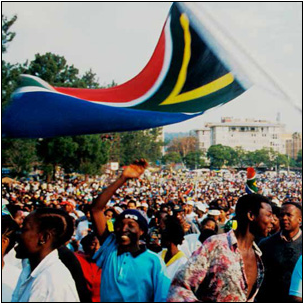 For decades the country was divided along racial lines, ruled by a government that oppressed the majority of its people and was a place where all citizens did not enjoy the same rights.
For decades the country was divided along racial lines, ruled by a government that oppressed the majority of its people and was a place where all citizens did not enjoy the same rights.
Yet despite this past, 20 years ago the country became a beacon of hope for the rest of the world, emerging united after the first democratic elections in 1994.
This year is one of celebration of all South Africans as the country marks 20 Years of Freedom.
To some people, freedom might mean the ability to do certain things that they were not allowed to do under the apartheid regime, such as moving freely in their country of birth.
Others might point to the democracy and freedom achieved in 1994 when all South Africans, irrespective of skin colour, voted in the country’s first democratic elections.
To others, freedom might mean the ability to associate with anyone they feel comfortable with, while some might highlight important issues like freedom of speech, freedom of religion and freedom of the media.
To David Maimela, researcher at Mapungubwe Institute for Strategic Reflection (MISTRA), freedom means being fully human.
MISTRA is an independent research institute that studies the strategic challenges facing South Africa.
“Freedom is to see yourself being treated as a human being with equal rights and responsibilities. The right to be able to live your life with dignity, free from oppression and exploitation.
“At a basic level it means freedom to live and have shelter, food, clothes and access to education and information to exercise your responsibility to improve yourself, others and the world you live in,” he explained.
Maimela said since the dawn of democracy in 1994, there has been a notable change in the lives of South Africans as a result of government’s intervention.
These include the provision of basic services with more South Africans enjoying access to water, electricity, sanitation, education and health care than ever before.
By 2011/12, more than 95 per cent of households had access to a basic level of water compared to about 60 per cent in 1994/5 and approximately 83 per cent of households had access to a basic level of sanitation compared to 50 per cent in 1994/5.
By 2013/14, 86 per cent of households had access electricity up from just over 50 per cent in 1994/5. On the health front, patients receiving anti-retrovirals increased to more than 1.7 million in 2011 up from 47 500 in 2004.
Maimela pointed out three key points that helped establish a democratic South Africa and strengthen the country further after 1994.
The first, he said, was South Africa’s approach in resolving political differences, where the leaders came together to find peaceful solutions, instead of allowing the situation to turn violent.
The second, Maimela pointed out, was that government acted decisively on issues that needed its intervention such as providing housing and health care.
The third he referred to was the space government created for public dialogue. It is in this space that South Africans can debate any issue without fear.
Despite these huge strides and the improvement in the lives of South Africans, challenges still remain such as poverty, unemployment and inequality.
Maimela said government led interventions are not enough and more still needs to be done.
“Socio-economic freedoms are still out of reach for majority of blacks and the working class. The state has tried to improve the quality of lives through initiatives such as increasing access to education and health, expanding the social safety net for the most vulnerable through social grants, free basic water and electricity, the Extended Public Works Programme and other job creation schemes. But that’s a minimal stop-gap measure programme and approach.”
For the country to deal with challenges such as youth unemployment and poverty, the economic and political elite need to come together and pull in one direction, he said.
More progress would be realised if political leaders and those with economic power made decisions for the collective good of all South Africans, Maimela added.
Government is well aware of the challenges it faces.
In his recent State of the Nation Address, President Jacob Zuma said: “Our country still faces the triple challenge of poverty, inequality and unemployment, which we continue to grapple with. Dealing with these challenges has become a central focus of all democratic administrations.”
“South Africa is a much better place to live in now than it was before 1994. We continue to face challenges. But life will also continue to change for the better,” he added.
South Africans talk freedom
South Africans talk freedom sadminAs South Africa celebrates 20 Years of Freedom, the questions on everyone’s lips are what is freedom, what does it mean to be free and how have people benefited from freedom?
Vuk’uzenzele posed these questions to a range of South Africans.
 Dumisani Boraga (MAFIKENG)
Dumisani Boraga (MAFIKENG)
Freedom means being able to participate in the economy, politics and social well-being of our country. All citizens of the country co-exist equally without racial discrimination. My life is no longer confined to racial superiority. I can now participate in a political party of my choice and express my political views. Freedom is a sense of belonging in our country.
Jennifer Wen (Cape Town)
To me freedom means the ultimate restoration of the human dignity our parents and grandparents were unable to experience in South Africa. Freedom means opportunities are available to my five-year-old son so he can prosper in his future. The freedom of our country changed my life as a woman. I am empowered as a woman, more so than women before 1994. I am also respected because not only does my vote count but my opinion as well.
Kayshree Govender (Johannesburg)
Freedom means to be free from oppression and the opportunity to stand together as one and embrace our country’s diversity. As individuals we need to respect and be thankful for the freedom that others were willing to die for. Freedom has opened up more opportunities for me and given me the right to vote for change and the right to be heard.
Andre Thomas (Bloemfontein)
In a country there should be no limitations on people living within the law. Freedom has increased opportunities.
Government tackles poverty, inequality
Government tackles poverty, inequality sadminGovernment has made great strides in creating jobs, uplifting communities and reducing poverty over the past 20 years.
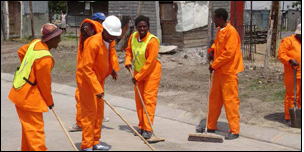 Since 1994, creating jobs has become a national priority and government departments, state-owned-enterprises and even the private sector have jumped on board. The social grant programme, introduction of minimum wage levels for workers who do earn a lot and government employment schemes have all helped fight poverty.
Since 1994, creating jobs has become a national priority and government departments, state-owned-enterprises and even the private sector have jumped on board. The social grant programme, introduction of minimum wage levels for workers who do earn a lot and government employment schemes have all helped fight poverty.
Flagship projects such as the Expanded Public Works Programme (EPWP), the Jobs Fund and New Growth Path were launched.
The EPWP is the national programme aimed at alleviating poverty and unemployment through work opportunities and skills development for poor, unskilled and unemployed South Africans.
According to the Twenty Year Review released by the Presidency, the programme has created over three million work opportunities across all its four sectors - infrastructure, environment and culture, social and non-state. From 2004 to 2009, 1.6 million jobs were created. The EPWP is on track to achieve its overall target of creating 4.5 million work opportunities by the end of 2014.
In 2011, R9 billion was also allocated to the Jobs Fund to finance job creation initiatives with a further R10 billion from the Industrial Development Corporation (IDC).
Small-scale sugar cane farmers in Mpumalanga recently benefited from the Jobs Fund. Thanks to a grant of R50 million, over 1 500 jobs have been created and the farmers are now able to increase production from 450 000 tons of cane a year to 850 000 tons.
Government’s New Growth Path aims to create five million jobs by 2020 and bring South Africa’s unemployment rate down to 15 per cent. At the launch of the New Growth Path, President Jacob Zuma highlighted government’s goal. “We want to have a country where millions of South Africans have decent employment opportunities and a high quality of life,” he said at the time.
Inequality
South Africa remains one of the most unequal countries in the world and inequalities in gender and race are still reflected in the labour force. According to the review, by 2001 incomes differed between men and women, with the average annual income of households headed by women around R27 864, compared to the R63 626 for households headed by men. By 2011, despite an increase in the average income for women, households headed by women earned less than half compared to men.
By 2012, the average income of an African household was under R3 000. For coloureds and Indians it was just over R7 000, while for whites it was around R20 000.
The past decade has seen the rise of the black middle class.
The review notes that there was a significant shift in the country’s LSM (Living Standard Measure) distribution between 2001 and 2010.
LSM is a tool to group populations in terms of their living standards, based on the goods, services or luxuries available to them.
The ranking ranges from 1 (poorest living standards) to 10 (highest living standards).
Between 2001 and 2010, LSM 1-4 shrank by 4.6 million, LSM 5-6 increased by 5 million, and LSM 7-10 also grew by 4.7 million.
“Although inequality remains high, poverty levels have decreased. Studies conducted by the Economic Policy Research Institute, the Development Policy Research Unit and the Southern Africa Labour and Development Research Unit at the University of Cape Town all indicate a reduction in poverty levels since 1994,” the review adds.
The reduction in poverty over the past two decades is an important milestone achieved by the democratic government.
“Despite the gains in overall poverty reduction, women, children and people with disabilities remain especially vulnerable to poverty,” the review notes.
Creating jobs, saving the environment
Creating jobs, saving the environment sadminSix months after joining the Eco Furniture project - a job creation initiative that produces eco-friendly furniture - Gugu Mbhele’s life has changed for the better.
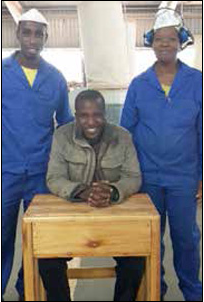 Worries about placing food on the table and her children’s school fees no longer fall on the shoulders of her husband, who was the family’s breadwinner for many years.
Worries about placing food on the table and her children’s school fees no longer fall on the shoulders of her husband, who was the family’s breadwinner for many years.
“It makes me very proud. As a woman I can now do these things for my family. I now help buy clothes and groceries and our lives are so much better,” says the 32-year old.
Mbhele is one of the 90 employees working at the Eco Furniture factory in Durban. The Expanded Public Works Programme (EPWP) project is funded the Department of Environmental Affairs, with the South African National Parks (SANParks) as the implementing agency.
As part of the project, invasive alien vegetation - trees that extract excessive water – are cut down. The trees are then processed into planks that are sanded down and turned into products such as school desks and coffins, for government.
“I am so proud of the work I do. I am making furniture that will help children learn and improve their education. One day my children may even use the desks I make so I am making a big difference to the country with my work,” said Mbhele.
Since the project began, employees like Mbhele, from the surrounding villages of Clermont and Kwadabeka now have a chance at a better life. Sipho Mavundla, 29, has been working at the factory since 2011 and says the project gave him a new lease on life.
“I could not find a job before so I was at home trying to make ends meet. Now I take care of myself and my family and I am able to learn skills I can use for life.”
Project supervisor Sandile Motaung, who joined the project when it began, says when people see him, they see wood. “This job has become such a part of me. Together with government we are killing three birds with one stone - we are creating jobs for our people, helping the environment by getting rid of alien vegetation and improving the way children are educated.”
The factory in Durban is one of five Eco Furniture factories opened across the country.
To date the factory has manufactured over 6 000 desks which have been delivered to schools across the country. Boitumelo High School in the Free State is one of the recipients of the desks.
Principal Mhlophe Mkhosana says when he joined the school in 2012, classrooms had been vandalised and most of the furniture was broken.
“I am very grateful and there have been positive changes in the school since the new desk donation,” said Mkhosana.
Learners at the school are also grateful for the desks.
“I will keep my desk clean at all times to make sure that learners who come after me have a desk that is in good shape,” said Motsiri Mampai.
Social grants bring relief to the poor
Social grants bring relief to the poor sadminGovernment is helping millions of South Africans escape the burden of poverty every month by providing social grants.
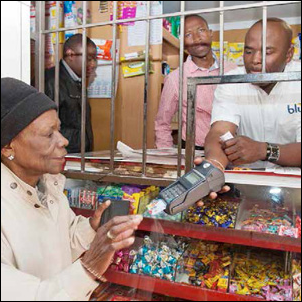 According to the Twenty Year Review released by the Presidency, “Social assistance through grants is the democratic government’s most effective poverty-alleviation tool. The Social Assistance Programme has been expanding at an unprecedented rate, with the number of beneficiaries increasing from 2.7 million people in 1994 to 16 million people by 2013”.
According to the Twenty Year Review released by the Presidency, “Social assistance through grants is the democratic government’s most effective poverty-alleviation tool. The Social Assistance Programme has been expanding at an unprecedented rate, with the number of beneficiaries increasing from 2.7 million people in 1994 to 16 million people by 2013”.
Child support grants were introduced in 1998 and initially targeted children aged seven and below. Over the years this was gradually extended to other age groups and by 2012, it also applied to children under the age of 18.
The old age grant was also normalised so that black people would receive a monthly income like their white counterparts. Before 1994 black South Africans would receive old age grants bi-monthly.
Over time the age limit for old age grants for men was lowered from 65 to 60 in line with the age limit for women.
Also the disability grant, foster care grant, care dependency grant and war veteran’s grant were extended to all South Africans.
About 2.9 million South Africans above the age of 60 receive old age grants, 11.3 million are beneficiaries of child support grants and 1.1 million receive disability grants, the review notes.
The child support grant has grown significantly, increasing from just under 22 000 beneficiaries in 1998 to more than 11.3 million in 2013.
While South Africa has been criticised for creating what some call a ‘nanny’ or dependent state by paying out grants, Social Development Minister Bathabile Dlamini pointed out why social grants are so important.
“We currently have more than a million orphans in the country. We have families that cannot find work, children who live with their grandmothers and children who take care of themselves and their younger siblings in childheaded households. Giving these children a grant is not creating a dependency. It is creating a support system to build a better foundation and a better life for these children. That is our overall goal,” said Minister Dlamini.
While millions benefit from social grants, criminals have also taken advantage of the system with many receiving grants illegally.
To address this problem, the department introduced cash-less smart cards for collecting grants.
With the new system, Nthabiseng Tshabalala, 84, from Orlando East, no longer has to queue for hours on end to receive her grant in cash every month.
Thanks to the South African Social Security Agency (SASSA) she, along with the other social grant recipients, received new smart cards last year.
The idea behind the cash-less system is to improve the lives of the poor and to stop fraud and corruption related to social grants.
Through state-of-the-art technology, Tshabalala and other recipients had their biometric details captured. “My fingerprints, my personal details and even my voice was recorded,” she said.
The unique feature about the smart card system is its ability to identify grant recipients by their biometric details. It includes 10 fingerprints, voice and other personal information, which makes it impossible for someone else to pose as a recipient to receive their grant.
In just under a year, SASSA managed to re-register about 22 million beneficiaries and issue 10 million cards.
According to SASSA Chief Executive Officer Virginia Petersen the system makes the lives of beneficiaries easier.
“In many cases we have a grandmother receiving a grant for older persons, a foster care grant or a child support grant. This new system puts all the payments onto one card, eliminating duplication and ensuring that only those who qualified received the grants,” she said.
An added bonus for beneficiaries is that they can now use the smart card at stores to shop, buy groceries and pay bills. “I can buy food.”
ECD - the building blocks of education
ECD - the building blocks of education sadminEarly Childhood Development (ECD) is one of the areas that government has prioritised since 1994.
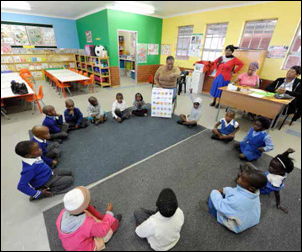 Through the Departments of Basic Education, Health, Social Development, and Women, Children and People with Disabilities, government ensures that young children are enrolled in Grade R or preschool, which are also known as ECD centres.
Through the Departments of Basic Education, Health, Social Development, and Women, Children and People with Disabilities, government ensures that young children are enrolled in Grade R or preschool, which are also known as ECD centres.
“ECD is critical for improving the results of learners in the education system,” the Twenty Year Review released by the Presidency notes.
ECD is crucial to a child’s development because it focuses on the stage when a child grows and flourishes mentally, socially and physically.
“Since 1994 there has been a significant increase in access to centre-based care ... It is estimated that over a million children under four years old are now in an ECD facility or some form of out-of-home care,” according to the review.
Enrolment in Grade R (a pre-school year at primary school) has more than doubled, increasing from 300 000 to 705 000 between 2003 and 2011, nearly reaching the level of universal access. By 2012, 87.8 per cent of learners in Grade 1 in public schools had attended Grade R.
“This is a remarkable achievement, indicative of South Africa’s investment in the foundation phase of education,” the review adds.
Government has stressed that the first one thousand days or first four years of a child’s life must be prioritised. This led to the establishment of the ECD programme, which was launched in July 2011.
One of the key elements of ECD highlighted by Social Development Minister Bathabile Dlamini recently, was the ECD subsidy of R15 per child per day. Currently, 467 000 children at 18 826 registered ECD centres are subsidised by government.
“The number of registered ECD facilities has also grown from 4 612 in the 2004 to over 21 000 by 2013,” she said.
ECD has been recognised as a powerful tool in breaking the cycle of poverty and making a real and lasting difference in children’s lives, the Minister added.
Government is committed to ensuring that every child, including those from poor backgrounds and with disabilities, has access to ECD at an early age.
While children benefit the most from ECD, the focus on it is also skilling teachers.
Bukeka Mandlantse runs Zizamele Educare, a preschool and aftercare centre in the Western Cape township of Khayelitsha. Mandlantse and her staff care for 50 children under the age of seven.
“I have always loved looking after children,” says the mother of two, who started teaching to protect the children in her community.
“I noticed there were a lot of children playing on the streets and I wanted to make sure they were protected from harm, like abuse and kidnapping.”
Mandlantse started working at Zizamele Educare in 2000 and was soon appointed principal. She then decided to register the school as an ECD facility, however faced a huge challenge. Like many other teachers in the area, she lacked a formal ECD qualification.
“I knew it was important to study but I could not afford it.”
With the help of Sikhulu Sonke, a community-based organisation aimed at improving the quality of ECD education in Khayelitsha, she completed an ECD Level 4 learnership. She is now using the knowledge she gained to the run the centre and care for the children.
“I learnt how to create and fill in application letters and now 47 out of my 50 learners are subsidised by government.”
Mandlantse urged other teachers to better themselves by gaining ECD qualifications, saying it would also improve the lives of the children they teach.
School feeding scheme keeps children in class
School feeding scheme keeps children in class sadminGovernment’s School Nutrition Programme is feeding millions of children across the country and helping ensure they attend class regularly.
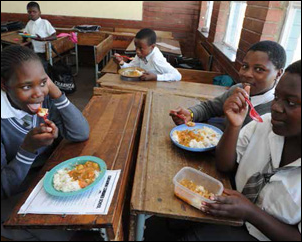 “By providing children with meals at school, the National School Nutrition Programme has contributed to regular and punctual attendance by learners and enabled them to attend school without being hungry,” says the Twenty Year Review released by the Presidency.
“By providing children with meals at school, the National School Nutrition Programme has contributed to regular and punctual attendance by learners and enabled them to attend school without being hungry,” says the Twenty Year Review released by the Presidency.
By 2012, about 9 million learners in 20 905 primary and secondary schools – virtually all the learners from poor households – were receiving a government-funded school lunch.
And it is not only children who are benefiting from the School Nutrition Programme. It has also given Joyce Moshwela, of Slurry in the North West, a job.
Moshwela cooks for the children of Onkgopotse Tiro Comprehensive School, who are beneficiaries of the School Nutrition Programme.
The school, which caters for Grades 1 to 12, is a no-fee school. “I think government is doing a good thing by ensuring that children receive food at school.
It helps the child to concentrate as they do not concentrate for long when they are hungry,” she said.
Moshwela is also grateful that government introduced the programme because it has provided her with a livelihood.
“I was unemployed for months until this opportunity came along. Not only do I have a job but I am also contributing to the upliftment of my community.”
Apart from the School Nutrition Programme, government also introduced the Integrated School Health Programme (ISHP).
The ISHP was launched by President Jacob Zuma in 2012 and provides essential health services to thousands of pupils especially in the country’s poorest schools.
Government also introduced the Human Papilloma Virus (HPV) vaccine at schools in March to reduce incidence of cervical cancer.
Fifty-four learners, aged between nine and 10 years, from Gonyane Primary School in Bloemfontein were among the first group of girls to get vaccinated against HPV. The target is to vaccinate about half a million girls against the virus for free.
Administered in private health institutions, the vaccine costs between R700 - R1 000.
“About 130 countries across the globe are vaccinating young girls for HPV. So far, about 170 million children have been vaccinated worldwide and I am proud to say the number has increased by 54 today,” said Minister Aaron Motsoaledi.
Three thousand health workers have been trained to work in the HPV vaccine programme in the country.
About 16 million women over the age of 15 are at risk of cervical cancer in South Africa. The Department of Health aims to reduce cervical cancer related deaths gradually within the next two to three decades through the vaccine programme.
Better matric pass rate, better prospects
Better matric pass rate, better prospects sadminEighteen-year-old Sechaba Ramerafe has ambitions of becoming a doctor.
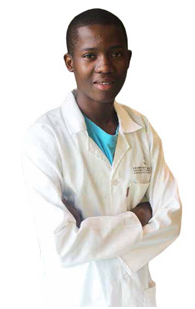 He is currently in his first year at university, studying towards a Biological Science degree at the University of Pretoria but will change his course in the second semester to achieve his dream.
He is currently in his first year at university, studying towards a Biological Science degree at the University of Pretoria but will change his course in the second semester to achieve his dream.
Ramerafe’s ambitions seemed a long way off, growing up in the farming village of Slurry in the North West, where he attended the Onkgopotse Tiro Comprehensive School.
But hard work and support from his teachers and family helped him breeze through his matric exams and achieve five distinctions in 2013. He was also at the top of his class.
Ramerafe explains that completing his matric was difficult and there were times when he thought of dropping out of school because of the poverty he had to deal with at home.
His mother is a domestic worker and father is unemployed. Ramerafe has six siblings and is the first in his family to attend university.
“I never saw myself completing matric because of my background. My standard of living was very poor. I did not think I would get anywhere in life,” he says.
The school he attended is a no-fee school for members of the community who are vulnerable but the class of 2013 still managed to produce a 100 per cent matric pass rate. More than eight million children now benefit from the no-fee policy.
Ramerafe and his classmates were among the matriculants who did the country proud, achieving a 78.2 per cent pass rate.
The Twenty Year Review released by the Presidency, notes that the matric pass rate has improved over the years and that more learners are also attending higher education institutions.
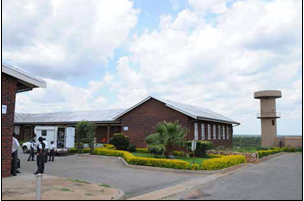 “On average, between 2010 and 2012, 128 000 learners obtained bachelor passes, compared with 70 000 per year for the period 2000 to 2002,” the review says.
“On average, between 2010 and 2012, 128 000 learners obtained bachelor passes, compared with 70 000 per year for the period 2000 to 2002,” the review says.
The matric pass rate has steadily increased over the past 20 years from 53.4 per cent in 1995 to 78.2 per cent in 2013.
The review attributes the improved pass rate to increased matric support programmes offered by the Department of Basic Education, as well as non-government organisations and the private sector.
This support includes intensive post-test analysis of question papers, self-study guides in selected subjects, revision camps for learners and supplementary winter schools, radio and television lessons in key subjects and the availability of examination examples and teacher support.
According to the review, the improvement in the pass rate is also because of a stabilised education system, which is no longer experiencing rapid changes in curriculum or policies.
All these interventions helped the class of 2013 achieve success, particularly those in the North West, where the matric pass rate increased from 50 per cent in 1997 to 87.2 per cent in 2013.
As for Ramerafe, he wants to return to the North West one day to give back to his community.
“I want to be a doctor to help the people of my village and later specialise in neurosurgery. I think that the brain has many secrets that still need to be discovered and I hope to discover these,” he said.
More opportunities for FET graduates
More opportunities for FET graduates sadminFurther Education and Training (FET) college graduates have more opportunities to look forward to thanks to government initiatives.
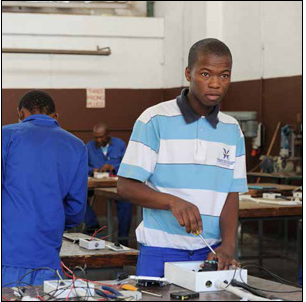 Recently the Department of Higher Education and Training (DHET) launched the Decade of the Artisan Campaign. The campaign aims to bridge the country’s artisanry skills gap and produce 30000 qualified artisans per year by 2024.
Recently the Department of Higher Education and Training (DHET) launched the Decade of the Artisan Campaign. The campaign aims to bridge the country’s artisanry skills gap and produce 30000 qualified artisans per year by 2024.
Higher Education and Training Deputy Minister Mduduzi Manana said the country currently produces 12 000 artisans a year. In terms of the National Development Plan (NDP), South Africa needs to produce 30 000 artisans a year to help grow the economy and reduce poverty.
“We want to increase the current number by 1000 a year until we reach 30 000 artisans a year,” said Deputy Minister Manana.
According to the Twenty Year Review, 3 430 artisans successfully completed trade tests between 2000 and 2006, while 6 030 artisans successfully completed trade tests between 2007 and 2008.
This number increased to 15 277 artisan qualifications during 2011/12 alone.
“Given the current shortage and growing demand for artisans, it is predicted that unless we take immediate action, artisanship will become an extremely scarce skill. The lack of artisans will also have a devastating impact on our economy down the line. Artisans play a crucial role in the delivery of services, especially in engineering trades,” he added.
The campaign will also promote artisanry as a career of choice to South Africa’s youth. More than 40 interactive community events will be held every three months at engineering campuses of FET colleges.
The Deputy Minister pointed out that artisanry was a great career choice as it almost guaranteed employment. To help FET graduates find job placement, the department recently launched the National Artisan Development Support Centre (NADSC). The centre currently focuses on linking graduates with work opportunities via employers in partnership with the Sector Education Training Authorities (Setas).
Food safety assistants
The Department of Tourism is also doing its bit to ensure that FET colleges graduates receives training and hands over job experience through the country’s first Food Safety Programme.
As part of the programme, 100 graduates will be placed in participating hotels across the country as food safety assistants. They will be trained to monitor and assess food and food safety issues, such as how food is stored, handled and served. The training will take place over 12 months during which time participants will receive a monthly stipend.
The programme is an initiative of the Department of Tourism and Federated Hospitality Association of Southern Africa (Fedhasa), and the Department of Tourism. The pilot project will see 100 graduates chosen from FET colleges in Limpopo, Mpumalanga and KwaZulu-Natal. Graduates will be mentored and taught how to package and store food to meet local and international food standards.
According to Fedhasa’s chairman Eddie Khosa, the programme is in support of government’s initiatives.
“Government made it a priority to boost FET colleges as the institutions of choice. This is why we have decided to absorb FET graduates to create this new career path within the hospitality industry … Creating jobs is also a huge focus of Fedhasa and this allows us to build skills and to better the lives of youth who come from impoverished communities.”
He said the programme would deliver sustainable jobs to the youth; jobs that were brand new in the industry and did not replace any existing positions.
Bursary scheme changes lives
Bursary scheme changes lives sadminGovernment has put in place a number of initiatives to ease the burden of fees on poor students who wish to study at tertiary institutions. One of the biggest initiatives is the National Student Financial Aid Scheme (NSFAS).
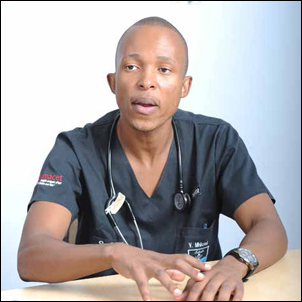 According to the Twenty Year Review released by the Presidency, “Between 1994 and 2012, approximately 1 million university beneficiaries received National Student Funding Assistance Scheme loans and bursaries worth approximately R30 billion”.
According to the Twenty Year Review released by the Presidency, “Between 1994 and 2012, approximately 1 million university beneficiaries received National Student Funding Assistance Scheme loans and bursaries worth approximately R30 billion”.
One such beneficiary is Vuyane Mhlomi, who is now a medical doctor. Growing up in a single-parent home in Khayelitsha, his dreams of studying medicine were always clouded by concerns over whether his family could afford it. However, through NSFAS, Mhlomi was able to study at the University of Cape Town and achieved his dream of becoming a doctor.
“The ultimate indicator of my achievement and success was the ability to study towards the career of my choice and through it I created positive changes in my community. Without financial barriers I’ve been able to reach my full potential and I have had the opportunity to meet and work with some of the leading minds in the world. I shudder to think that a little over 20 years ago equally talented people were denied the opportunity of higher education due to a lack of financial support.”
Like Mhlomi, thousands of students hoping to study at any of the 25 public universities and 50 public FET colleges throughout the country, now have opportunity to realise their dreams.
Lack of funding was also an issue for Cynthia August, the first ever student to receive NSFAS support in 1992.
“Many young people out there are not aware of how much NSFAS does for students who need financial assistance to help achieve their goals. I believe that if it was not for NSFAS I would have not become who and what I am today,” she says.
August obtained her Teaching Degree in 1994 from the University of Fort Hare and went onto to become the head of department at Hankey Secondary School in the Eastern Cape. Today she is also a counsellor for youth, education and gender affairs at the Gamtobaqua Khoi-San Council.
According to NSFAS, funding for students grew from R441 million in 1999 to R8.5 billion in 2013.
Another milestone for NSFAS was the introduction of the Final Year Programme in 2011, which ensures that students have their final-year loans converted into a 100 per cent bursary if they pass their final year courses and qualify to graduate. Through this programme government pledged R851 million, which will benefit 28 464 students. It encourages students to focus on graduating without worrying about repaying their entire loans and allows them to start working to repay the loans quicker and help other students who also need financial aid.
SA: A better place for all since 1994
SA: A better place for all since 1994 sadminSouth Africans, young and old, are reaping the benefits of living under a democratic government, with their lives improving for the better over the past 20 years.
Since the end of apartheid, the democratic government has drawn up policies, introduced programmes and set aside resources to provide South Africans with services and opportunities they did not previously enjoy.
As the country celebrates 20 Years of Freedom there is no denying that citizens now have access to better health care, homes, education and services than they did pre-democracy.
These achievements are reflected in the Twenty Year Review report, released by the Presidency in March.
The review also notes that South Africa’s economy is healthy, job opportunities are available, people of all races live together in harmony and the country is a major player on the world stage.
Health
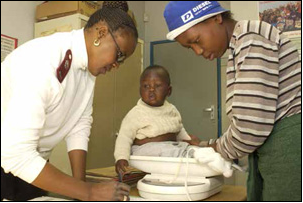 One of democratic South Africa’s greatest success stories has been its fight against HIV and AIDS, which was declared a government priority in 1994.
One of democratic South Africa’s greatest success stories has been its fight against HIV and AIDS, which was declared a government priority in 1994.
The country now has one of the largest antiretroviral (ARV) programmes in the world. This has helped reduce new HIV infections and deaths from AIDS.
Patients receiving ARVs increased from 47 500 in 2004 to more than 1.7 million in 2011, while the number of people dying annually from AIDS decreased from 300 000 in 2010 to 270 000 in 2011.
In another success, mother-to-child transmission rates decreased from 8.5 per cent in 2010 to 2.7 per cent in 2011.
The HIV Counselling and Testing campaign, aimed at encouraging South Africans to get tested for HIV, resulted in 20.2 million people being testing between April 2010 and June 2012.
Social assistance
Government has also thrown a lifeline to those living in poverty and with no means to support themselves in the form of social grants.
This social assistance programme – which includes child support grants, old age grants, disability grants, foster care grants and war veteran’s grants - has grown over the years, helping 2.7 million people in 1994 to more than 16 million currently.
Work opportunities
Government, through the Expanded Public Works Programme and the Community Work Programme, has created more than three million work opportunities over the past five years.
Currently 15 million people have jobs in the country, the highest ever in history and according to Statistics South Africa, over 650 000 jobs were created in 2013.
Going forward, government wants to make more jobs available to South Africans, with Cabinet setting a target of six million work opportunities from 2014 to 2019, targeting the youth.
The country’s economy has grown at 3.2 per cent a year on average from 1994 to 2012 despite the global recession, which resulted in the loss of a million jobs.
Improved housing
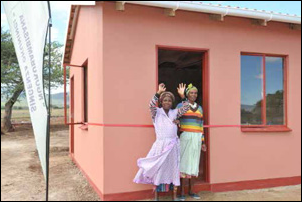 Government has built about three million houses since 1994, giving citizens homes they can be proud of.
Government has built about three million houses since 1994, giving citizens homes they can be proud of.
Those living in informal settlements have also had reason to celebrate with 500 informal settlements replaced with quality housing and basic services provided.
More than 12 million people now have a place to call home after government invested more than 100 billion in building new homes since 1994.
Education
Another basic right that has become more readily available to citizens over the past 20 years is education.
Gross secondary enrolment improved from 51 per cent in 1994 to 89 per cent in 2012, while gross primary enrolment in 2012 was high at approximately 98 per cent.
By 2012, 78 per cent of learners (more than 8 million) in 80 per cent of public schools (close to 20 000 schools) benefited from the no-fee policy.
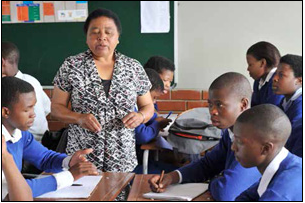 Not only are more South Africa children attending school than ever before, but their performance at school has also steadily improved.
Not only are more South Africa children attending school than ever before, but their performance at school has also steadily improved.
While in 2009 the matric pass rate stood at 61 per cent, the 2013 pass rate was a healthy 78 per cent.
Government is also giving young people every opportunity to continue with their studies after matric, despite their financial situation.
University enrolment has almost doubled, increasing from 495 356 students (at universities, technikons and teachers’ training colleges) in 1994 to 953 373 students (at public universities and universities of technology) in 2012.
Between 1994 and 2012, approximately one million university beneficiaries received National Student Financial Aid Scheme (NSFAS) loans and bursaries worth about R30 billion.
Land reform
Since 1994 thousands of families who were forced to give up their land under apartheid have been compensated.
During this time about 5 000 farms, comprising 4.2 million hectares, have been transferred to black people, benefiting over 200 000 families, President Zuma said in his State of the Nation Address (SONA).
In addition, 80 000 land claims, totalling 3.4 million hectares, have been settled and 1.8 million people have benefited.
Safety and security
Over the past two decades government has also worked hard to make the country safer.
The overall crime rate has decreased by 21 per cent since 2002 and work is on-going to make communities safer.
One of government’s priorities has been to curb violence against women and children. Measures introduced to help achieve this include the re-opening of the Family Violence, Child Protection and Sexual Offences Units as well as Sexual Offences Courts.
Basic services
When the democratic government took over in 1994, its first priority was to meet the basic needs of people.
The country can be proud of its efforts to ensure access to water as it met its Millennium Development Goal (MDG) – to halve the proportion of the population without sustainable drinking water – in 2008, ahead of the 2015 deadline.
Access to a basic level of water increased from just over 60 per cent of households in 1994/95 to over 95 per cent of households in 2011/12.
South Africa achieved similar success in the MDG of halving the proportion of the population without basic sanitation by 2015.
By 2011/12 about 83 per cent of households had access to a basic level of sanitation up from just 50 per cent in 1994/5.
By 2013/14, 86 per cent of South Africans had access to electricity, an increase from just over 50 per cent in 1994/5.
Reflecting on all these achievements, it is no wonder that President Zuma noted in his SONA: “As a country we have scored many successes. South Africa is much better place to live in now than it was before 1994”.
Primary health care changes lives
Primary health care changes lives sadminChristina Digwamaje has spent most of her life in the small village of Pella in the North West.
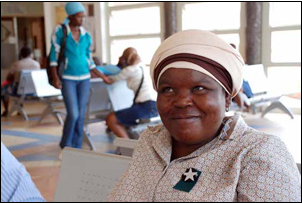 During that time, the 47-year-old has seen the area change from a place that offered very limited Primary Health Care (PHC) services to one that now boasts the Pella Health Centre.
During that time, the 47-year-old has seen the area change from a place that offered very limited Primary Health Care (PHC) services to one that now boasts the Pella Health Centre.
Over the past 20 years government has put a lot of focus and resources into PHC, through the building of clinics, health centres and community care workers who conduct home visits.
PHC aims to make health care more accessible and provides the means for South Africans to use nearby clinics and health centres as their first entry to the health system before being referred to hospitals. The Pella Health Centre is an example of a facility built post 1994 that has changed the lives of the previously disadvantaged.
Officially opened in 2008, it cost about R30 million and serves 11 258 people.
Patients from nine clinics, from 15km to 110km away, are referred to the centre where they receive treatment for hypertension, diabetes, TB and HIV, among others.
The centre runs a health education and nutrition promotion and has a laboratory and pharmacy. It has six trained community health workers servicing households, a resident doctor, dentist, psychiatric nurse, two midwives, a dietician, pharmacist, nine professional nurses and administrative staff.
“What I love most about this health centre is that its only two kilometres from my home. My whole family comes here when we are not well,” says Digwamaje.
In the past Digwamaje and other community members had to hire a car when they needed to see a doctor and the trip to the Moreteletsi Hospital is about 150km.
“When someone was in labour at night it was very hard to get to a health facility quickly.”
The Pella Health Centre is opened 24 hours a day and has a maternity waiting home for mothers-tobe who are close to their birth due date but live some distance from the centre.
The mothers-to-be live in the centre until they deliver the babies.
“The pregnant mothers from these neighbouring clinics are also attended to at the centre. We deliver about 12 babies in a month,” says Sister Boniswa Mekgoe, facility manager at the centre.
If there are complications obstetric ambulances transport the pregnant woman to the nearest hospital.
Interventions such as these have contributed to the decrease in the infant morality rate.
“South Africa has significantly improved its child health and reduced its infant and under five mortality rates. In 2005, it was one of only four countries globally with an under five mortality rate higher than the 1990 baseline for the MDGs.
“This rate declined by an average annual rate of 10.3 per cent between 2006 and 2011 – the fourthfastest rate of decline globally, with Rwanda being the only country in sub-Saharan Africa to achieve faster progress,” according to the Twenty Year Review.
Twenty years ago there were very few PHC facilities meeting the health needs of communities.
The democratic government then introduced a massive infrastructure programme that resulted in more than 1 500 health facility infrastructure projects being completed, the review notes.
Health Minister Aaron Motsoaledi, who described PHC as the backbone of the National Health Insurance (NHI) has intensified the focus on PHC and introduced three streams - district specialists, school based health programme and municipal ward based PHC agents.
District specialists include a principal obstetrician, principal paediatrician, principal family physician, advanced midwife and senior primary care nurse.
These specialists train interns, community service doctors and medical officers. They are the link between the prevention and management and cure of diseases.
According to the Department of Health, as of November 2012, 163 district specialists were appointed to the 46 districts in the country.
School health teams visited 1 610 poor schools between July and September 2012. They offered services to patients with eye-care, dental and hearing problems, and immunised learners.
To improve PHC, 10 000 primary health care workers were trained and assigned to municipal wards in the country.
All these efforts are improving South Africans’ access to health care.
NHI: Quality health care for all of SA
NHI: Quality health care for all of SA sadminSouth Africa is making significant progress with the National Health Insurance (NHI) - a financing system that will make sure all South Africans get essential health care, regardless of how much they earn.
The NHI aims to eliminate the barriers limiting access to health care. National Treasury is working with the Department of Health to examine the required funding arrangements for NHI.
Government has put in place the building blocks for NHI such as re-engineering primary health care.
The NHI will address the country’s health burden and ensure that South Africans become a healthy, productive nation.
As part of the first phase in 2012, 11 pilot districts were identified to test the feasibility of the NHI.
The pilot districts are OR Tambo (Eastern Cape), Gert Sibande (Mpumalanga), Vhembe (Limpopo), Pixley ka Seme (Northern Cape), Eden (Western Cape), Dr K Kaunda (North West), Thabo Mofutsanyane (Free State) and Tshwane (Gauteng).
Due to the high population and disease burden, two were identified in KwaZulu-Natal - uMzinyathi and uMgungundlovu. However, the province added a third district, Amajuba, at its own cost.
 Vuk’uzenzele asked South Africans about their thoughts on the NHI.
Vuk’uzenzele asked South Africans about their thoughts on the NHI.
Sifiso Zulu
The NHI is a good idea because we all need health care as it is enshrined in our Constitution. I hope that government will manage the insurance correctly.
Romita Hanuman
The NHI will consolidate health care into one point ensuring that every South African receives proper health care. Government is doing a good thing. Every little step and progress that the country makes should be commended.
Louise van Niekerk
The NHI is a good idea, as it will help people who cannot afford proper health care. However, I think before the NHI can be implemented, government must ensure that there are enough properly trained and dedicated health care professionals who have a strict work ethic.
Bheki Mahlangu
For the man on the street the NHI will be a life changing initiative. Living in a country that consists mostly of people that have no access to basic health care is a problem. Big changes will take place with the introduction of the NHI.
Local govt takes services to communities
Local govt takes services to communities sadminSignificant advances have been made over the last 20 years to establish a single local government system from the fragmented, undemocratic, unaccountable and racially divided apartheid system.
“It is impressive that a number of municipalities which had little or no preexisting institutional foundations, have been able to deliver basic services to thousands of people who did not have them before in the past two decades,” President Jacob Zuma said during the release of the Twenty Year Review recently.
The review, records the achievements that the country has made since the dawn of democracy in 1994, states the challenges that have been experienced, mistakes that have been made in some instances and takes a look at possible recommendations.
President Zuma said some of the municipalities were geared towards serving a minority before 1994. The focus is now on reaching communities that are still waiting for services, like those in remote rural areas and in informal settlements.
More importantly, he said, the focus is on improving the technical and management expertise of municipalities so that they can function better and also be able to maintain key infrastructure that supplies water and electricity to communities.
The 1998 White Paper on Local Government paved the way for a modern local government system with clear developmental objectives.
The number of municipalities was rationalised from 843 before 2000 to 283 just before the 2011 municipal elections and a new fiscal framework was introduced that guaranteed local government a share of national revenue. Policies and support structures were put in place with the aim to build the capacity of local government to deliver municipal services.
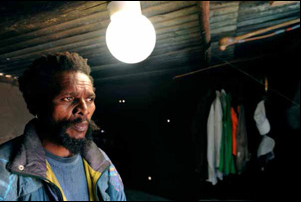 In the past two decades, municipalities have delivered basic services to millions of households that did not receive them before.
In the past two decades, municipalities have delivered basic services to millions of households that did not receive them before.
“Given that a number of municipalities had little or no pre-existing institutional foundations on which to build, and where these existed, they were geared towards serving the needs of a minority, this is a remarkable feat. However, local government is still in the process of transformation and many challenges remain for local government service delivery,” notes the review.
It says remaining backlogs and unevenness in the quality of service delivery contribute to deep-seated dissatisfaction in some communities, as evidenced by the rise in service delivery protests.
Research shows there is a significant decline in public opinion of government’s performance in delivering basic services, together with an increase in the number of major service delivery protests.
“These trends highlight the importance of effective engagement with citizens in order to ensure that concerns are heard and addressed, as well as the need to maintain and strengthen government’s focus on improving the quality of service delivery.”
Municipal support
Many municipalities have been affected by a shortage of technical skills, resulting in difficulties in delivering on their mandates.
The Municipal Infrastructure Support Agency (MISA) was established in 2011 to support municipalities with planning, management and other technical expertise to rollout infrastructure more efficiently and effectively - especially in weaker municipalities.
The review notes that MISA is currently providing technical capacity support to 107 municipalities with a total of 77 technical experts (engineering and planning professionals) assigned to support these municipalities.
“Signs of improvements in project implementation, spending of allocated conditional grants funds ... and infrastructure maintenance and refurbishment are evident in the municipalities that are being supported.”
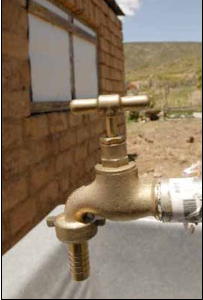 National government has allocated substantial funds to build municipal capacity since 1994. The Siyenza Manje Programme spent about R933 million in the period 2006/07 to 2009/10. Almost R5.8 billion has been allocated for municipal capacity support between 2013/14 and 2016/17.
National government has allocated substantial funds to build municipal capacity since 1994. The Siyenza Manje Programme spent about R933 million in the period 2006/07 to 2009/10. Almost R5.8 billion has been allocated for municipal capacity support between 2013/14 and 2016/17.
Going forward, this support will need to be continued and improved as some municipalities are still struggling to build, refurbish, operate and maintain the infrastructure needed for reliable and sustainable service delivery.
Management and operational capabilities in key areas will need to be strengthened, says the review, adding that this is especially true in some rural municipalities, which have a weak rates base and are often unable to recruit and retain critical skills.
Deepening participatory democracy
South Africa has made great strides in creating mechanisms for citizens to participate on an on-going basis and not just during elections. Participatory governance and advisory structures, consultative forums and grievance mechanisms have been established to enable citizens to participate in and inform governance processes.
Protests are typically prompted by a range of concerns, including access to services, the quality of services and the perceived nonresponsiveness of local government.
“The priority is therefore to ensure that mechanisms for promoting participation, accountability and responsiveness are used effectively ... Attention needs to be given to improving accountability mechanisms for routine day-to-day interactions between citizens and the state, particularly at the point of delivery.
“More emphasis needs to be put on engaging citizens in their own spaces rather than only expecting them to use forums and structures established by the state,” reads the review.
At local government level, there is a particular need to ensure that participation in the Integrated Development Planning (IDP) processes is deliberative, with citizens being involved in identifying and resolving trade-offs rather than simply developing shopping lists of needs.
Traditional leadership
One of the objectives of the White Paper on Traditional Leadership and Governance was to ensure that traditional leadership structures are in line with the principles of the Constitution.
The National House of Traditional Leaders was established in 1997. In 2004, after consultation with the traditional leadership institutions in the country, government established an Independent Commission, commonly known as the Nhlapo Commission. The purpose of the commission was to address disputes and claims on traditional leadership.
In 2009, the Department of Traditional Affairs was established to support the institution of traditional leadership.
The Traditional Affairs Bill has been drafted to consolidate national legislation dealing with traditional leadership and make statutory provision for the recognition of the Khoi-San communities and leaders.
The National Khoi-San Council, consisting of 30 members drawn from the five main groupings of Khoi-San society, was established.
The Traditional Courts Bill, which was intended to affirm the recognition of the traditional justice system and its values and to regulate the role of traditional leadership in the administration of justice, faced strong opposition from a range of civil society groups and ordinary citizens, especially women in rural areas resulting in its withdrawal in December 2012.
The Bill is perceived by some as undermining equal citizenship rights and of imposing a segregated legal system on those living in the former homelands.
As a result, the statutory deadline of 30 December 2012, by which the Bill should have been enacted into law, has not been met and consultations on the Bill are on-going.
SA’s land reform policies producing results
SA’s land reform policies producing results sadminSince 1994, government has transferred millions of hectares of land back to the black majority who were removed from their ancestral land over 100 years ago.
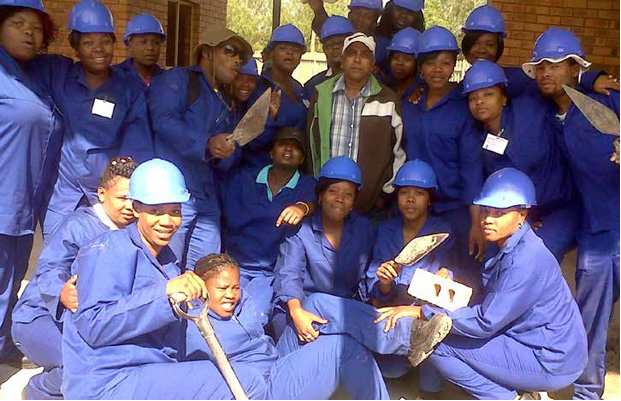 According to the Twenty Year Review, in 1994 most agricultural land (83 per cent) was owned by whites and only 17 per cent of the land was available for black people in the former homelands.
According to the Twenty Year Review, in 1994 most agricultural land (83 per cent) was owned by whites and only 17 per cent of the land was available for black people in the former homelands.
As the country celebrates 20 Years of Freedom, efforts to undo this historical injustice are starting to bear fruit, even if it is at a slower pace than anticipated.
Following the democratic elections of 1994, government undertook to transfer 30 per cent of agricultural land (24.5 million hectares) to black people by 2014.
In his State of the Nation Address (SONA), President Jacob Zuma said so far 5 000 farms amounting to 4.2 million hectares have been transferred to black people benefiting over 200 000 families countrywide.
In 2009, government established a department that was given the responsibility of dealing with the land issue, specifically the social and economic development of rural areas in country.
The Ministry of Rural Development and Land Reform (DRDLR) was set up and government prioritised rural development and the needs of people living in rural areas.
Over the years government has introduced various initiatives and programmes aimed at accelerating the land transfer process. Among these initiatives is the approval of the Restitution of Land Rights Act in 1994.
The Act helped government in its effort to transfer land back to its rightful owners. Within a period of four years, the Act resulted in 80 000 claims lodged for restitution by 31 December 1998.
Programmes such as Comprehensive Rural Development Programme (CRDP), Recapitalisation and Development Programme (RADP), Agrarian Transformation, Land Reform and the National Rural Youth Service Corps (Narysec) were introduced with the aim to fast track the land reform and rural development process.
Comprehensive Rural Development Programme
Under the CRDP, 2 447 household food gardens have been established at various sites. By January 2013, over 2 600 beneficiaries were skilled in technical enterprise development trade.
Fifty-two councils of stakeholders, which are made up of government, labour, community development workers, civil society and business, have been established. These councils, with the help of government, plan, implement and oversee CRDP initiatives.
The CRDP has been rolled out to 157 rural wards, 143 698 poor households were profiled to assess their needs, 692km of fencing was erected in CRDP wards and 96km of roads were upgraded.
National Rural Youth Service Corps
Narysec is a youth skills, development and employment programme aimed at empowering rural youth from each of the 3 300 rural wards in the country.
The objective of Narysec is to recruit rural youth between the ages of 18 and 35 to provide services in their communities. Participants are contracted for 24 months following their recruitment.
Narysec was launched in 2011 as part of the National Youth Service with an initial 7 900 participants, of which about 4 500 have either received or are in the process of completing training in various skills.
Communal Property Associations
The Communal Property Associations (CPAs) Act allows communities to form associations called CPAs to acquire, hold and manage land on behalf of community members. Members of the CPA must live in the area where the land is situated. They ensure that the land is used and managed effectively for the benefit of the community.
Rural Cooperatives Finance Facility
Recently Rural Development and Land Reform Minister Gugile Nkwinti said government was planning to establish a facility to provide financial support to small-holder farmers.
“Going forward, the government will establish the Rural Cooperatives Finance Facility (Rucoff), to provide much needed financial and other technical support to a fledgling class of small-holder farmers and cooperatives in both commercial and communal land spaces.”
According to Minister Nkwinti, emerging small-holder farmers sought assistance from government.
“During interactions, emerging small-holder farmers and cooperatives have expressed a wish that the government procure from them so that they could grow and be sustainable.”
Transfer of land
While most of the arable land is still in the hands of the white minority, nearly 5 000 farms have been transferred to black people. Nearly 80 000 land claims, totalling 3.4 million hectares, have been settled and 1.8 million people have benefited.
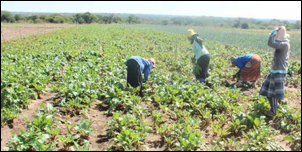 Though government has made progress in transferring land back to black people, a lot still needs to be done. The total amount of farmland transferred by means of restitution and redistribution is about 8 per cent, well short of the original 30 per cent target.
Though government has made progress in transferring land back to black people, a lot still needs to be done. The total amount of farmland transferred by means of restitution and redistribution is about 8 per cent, well short of the original 30 per cent target.
Since the inception of the land restitution programme in 1995, 79 696 claims were lodged, 77 334 have been settled of which 59 758 were finalised. The pace of settling these claims has improved over time as the system matures.
To overcome challenges facing government in the transferring land, the review suggests improving coordination between the spheres of government and implementation of rural development initiatives.
Pro-active citizens, private sector participation and expanding successful service models for rural areas are some of the ways identified as critical to assisting government to transfer land back to rightful owners.
During the SONA, President Zuma also said government should shorten the time it takes to finalise a claim.
“In this regard, government will now pursue the ‘just and equitable’ principle for compensation, as set out in the Constitution instead of the “willing buyer, willing seller” principle, which forces the state to pay more for land than the actual value,” he said.
President Zuma added that all was not lost for people who missed the deadline to lodge claims.
“…there are proposed amendments to the Restitution of Land Rights Act, 1994 in order to provide for the re-opening of the lodgement of restitution claims, by people who missed the deadline of 31 December 1998.”
He said another issue that would be “explored” was exceptions to the June 1913 cut-off date to accommodate claims by the descendants of the Khoi and San as well as heritage sites and historical landmarks.
Reclaimed land puts communities on path to success
Reclaimed land puts communities on path to success sadminUnder the apartheid regime the lives of black communities across the country were disrupted. Many were forcibly removed from their ancestral land, the only home they knew, as a result of apartheid laws.
According to the Twenty Year Review, in 1994 most agricultural land (83 per cent) was owned by whites and only 17 per cent of the land was available for black people in the former homelands.
Over the past two decades, thousands of families who were forced to give up their land under apartheid have been compensated or handed back land.
Government introduced various land reform policies and initiatives aimed at giving land back. Since 1994, 5 000 farms, comprising 4.2 million hectares, have been transferred to black people, benefiting over 200 000 families.
In addition, 80 000 land claims, totalling 3.4 million hectares, have been settled.
Beneficiaries
Among the beneficiaries of land restitution are communities that were evicted from their ancestral land in the Maile, Mmamerotse, Tantanana, Bethanie, Phalane and Jericho villages, outside Brits in North West.
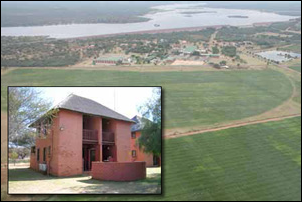 The evictions here took place in 1922, 1923 and 1963.
The evictions here took place in 1922, 1923 and 1963.
In 1995, when government invited people to launch claims, the six villages joined hands to launch one claim because the land they were evicted from was now called Tweerivier 197 JQ.
In 1999 they succeeded with their claim and government bought back 6 100 hectares of land on their behalf. Efforts by community members to return to their ancestral land were delayed by infighting. Other members from different villages launched a counter claim and that distracted the process.
According to community member Charles Moagi, government told them that until they sorted out their differences, no land would be handed over to them. “The counter claim by others and the infighting dealt the two groups a blow as both of them could not receive the land they had claimed,” he said.
Joint claim
In 2004 the two groups decided to come together, formed a Communal Property Association (CPA) and launched a joint claim. That’s when things started to move in the right direction. They agreed on the name Dikgatlhong for the CPA and came up with a memorandum of agreement binding them to work together.
“Dikgatlhong was chosen because the name itself means the coming together and it united the two groups. We realised that the infighting wasted a lot of energy and time, hence we came together,” said Moagi, chairperson of the Dikgatlhong CPA, which represents 203 families.
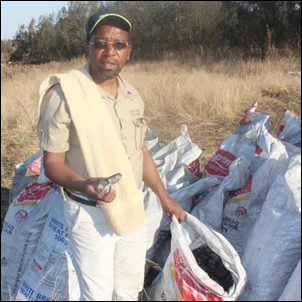 The CPA manages the land, which is divided into various sections, on behalf of the families. Dikgatlhong Game Farming and Lodge occupies 2 000 hectares, irrigation crops occupies 3 340 hectares and the cattle farming project occupies 565 hectares - all of which was bought by the Department of Rural Development and Land Reform for the community. The farm produces maize, soya beans, sunflowers and vegetables.
The CPA manages the land, which is divided into various sections, on behalf of the families. Dikgatlhong Game Farming and Lodge occupies 2 000 hectares, irrigation crops occupies 3 340 hectares and the cattle farming project occupies 565 hectares - all of which was bought by the Department of Rural Development and Land Reform for the community. The farm produces maize, soya beans, sunflowers and vegetables.
“Though the land belonged to our ancestors, government wanted us to explain in detail what we wanted to do with the land and that’s when we came up with what we called the master plan. That plan explained in detail what we wanted to do.
“It spoke about our plans to lease some of the land, plough some of the land and involve our young people in the running of the lodge,” explained Moagi.
He added that to prevent the possibility of the farm collapsing, they established a good working relationship with the previous occupants of the farm.
“We retained the skilled people who were working on the farm to ensure that there was continuity and skills transfer.”
Bursary scheme
The lodge created 25 direct jobs and employed locals from different villages. It created part time jobs and there’s also talk of starting a bursary scheme for young people who want to pursue a career in farming, game and wildlife conservation.
Moagi said the secret of Dikgatlhong’s success was that they did not antagonise the previous owners and occupants of the farm. He warned other CPAs not to fall into the trap of alienating the previous owners of land, as this would prevent skills transfer to the new occupants.
Babanango
Another community to benefit from the land restitution programme is that of Babanango in Zululand, north of KwaZulu-Natal.
In the 1950s, 192 families had to leave behind this land – dubbed little heaven because of its majestic mountains, flowing rivers and wildlife - as part of apartheid’s forced removals.
In 1997 these families, under the banner of the Emcakwini Community Trust, lodged a claim to get their land back.
Ten years later the land was handed over to the trust and the people of Babanango put the land to work, said the trust’s chairperson Eric Buthelezi.
“The community has now turned pain into prosperity by making sure that the 19 000 hectares of land is used to improve the community,” he added.
Businesses
The trust’s beneficiaries have set up lucrative, sustainable businesses such as farming, forestry, charcoal manufacturing and sew milling. With all these businesses, the trust is the leading employer in Babanango, employing about 160 people.
When the trust received the land, most of the wattle, gum, and pine trees on it were damaged.
“We decided to take the damaged trees and turn them into coal. This helped bring cash flow into our business and also made way to plant new trees where the damaged ones were.”
This gave birth to the trust’s charcoal business in 2008. To kick things off, the trust bought charcoal ovens needed to make charcoal. It was through the sale of charcoal that the trust started paying off its debt.
The charcoal business employs about 24 people. “We sell the charcoal to a company called Coastal Fires in Stanger. The agreement is to supply them as for as long as we can,” Buthelezi said.
The trust received R5 million from the National Development Agency (NDA) for their charcoal business. The trust also produces crop and recently harvested 500 hectares of vegetables such as mealies and beans, which bought 20 employment opportunities.
In addition, there are two lodges on the land, one of which is operational.
“The owner of the Babanango Guest Lodge pays occupational rent to the trust and employs about 40 people. Our land is also rich in game. We have zebras, bucks and impalas which serve as a tourist attraction.”
The trust also has a sew milling plant, which produces beams used in houses. These beams are made from the trees on the land. “The plant employs about 15 people from the community,” said Buthelezi.
Buthelezi’s ultimate aim is for the young people of Babanango to benefit from the trust’s initiatives.
Emcakwini Community Trust’s success is a testament to what South Africans, who have been victims of injustices in the past, can achieve under a democratic government.
Restoring dignity through better homes
Restoring dignity through better homes sadminWhen Samuel Kubayi arrived in Johannesburg in 1996 from the Eastern Cape, his goal was to find a job in the City of Gold and build a proper home for his family.
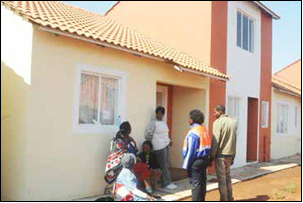 After struggling to raise enough money to build a house, he rented a backroom at a friend’s house in Protea South, Soweto. This would be his home for more than 15 years.
After struggling to raise enough money to build a house, he rented a backroom at a friend’s house in Protea South, Soweto. This would be his home for more than 15 years.
Kubayi’s situation changed when he received a letter in 2011 telling him that he would soon own a house in a 24 000 mixed income housing development, situated west of Dobsonville, Gauteng. By then, he had been on the housing waiting list for 14 years. He is now the proud owner of a two-bedroom house with his own bathroom, which has a shower, bath, basin and toilet. He enjoys warm water from the government-sponsored solar geyser installed at his home. Schools, clinics and recreational facilities are all less than a kilometre from his home.
Kubayi is one of the millions of South Africans who have benefited from the houses built by government over the past two decades.
According to the Twenty Year Review released by the Presidency, since 1994 the democratic government has delivered approximately 3.7 million subsidised housing opportunities for the very poor, giving a home to approximately 12.5 million people.
The review notes that when the new government came into power two decades ago, the housing backlog in South Africa was estimated at 1.2 million houses. The 1996 Census showed that 1.5 million households lived in informal houses in urban areas. In 1994, authorities also inherited a practice where housing was delivered through a fragmented system of some 14 race and ethnicity-based administrations into separate racial areas.
Opportunities for blacks to purchase and own land were limited. This created a highly distorted property market, with a functioning housing market for a white minority and a series of public rental housing “black ghettoes” for blacks in urban areas. There was no proper housing in rural areas.
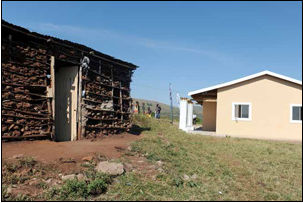 Black housing conditions were characterised by overcrowding of the existing public housing, limited new affordable housing, high private rentals and deteriorating municipal services. The system left people like Kubayi, who emigrated from rural areas to find jobs in the city, with no other option but to become backyard dwellers. Others found themselves building shacks in growing illegal informal settlements, which rapidly spread out on the outskirts of major cities.
Black housing conditions were characterised by overcrowding of the existing public housing, limited new affordable housing, high private rentals and deteriorating municipal services. The system left people like Kubayi, who emigrated from rural areas to find jobs in the city, with no other option but to become backyard dwellers. Others found themselves building shacks in growing illegal informal settlements, which rapidly spread out on the outskirts of major cities.
To lessen the burden on government’s lowcost housing system, also known in township terms as ‘RDP houses’, government introduced other methods, including the Social Housing Programme (SHP).
The SHP has so far delivered an estimated 50 000 new housing opportunities for many low and moderate-income households. Most of these developments are found in major economic cities like Johannesburg and Cape Town. An example of a SPH-inspired mixed housing is the Lufhereng housing development, which was unveiled in Johannesburg in 2012.
The development, like similar ones across the country, has been designed to make owning houses possible for people like Kubayi, who struggle to get finance from banks because of low income.
Lufhereng was conceived by the City of Johannesburg and the Gauteng Department of Local Government and Housing as a large scale, mixed-income and mixed-type housing development. It falls under the Mixed Housing Development Programme, designed under the National Housing Strategy’s Breaking New Ground policy, which has been endorsed by national government.
Once fully complete, the development is expected to yield 24 000 houses.
According to city officials, the project included a significant component of urban agriculture, through small-scale intensive urban agriculture open-field plots, hydroponic farming units and fish breeding schemes.
Children will be able to attend school starting from primary up to high school at Lufhereng. “This is home for me. Gone are the days where you will just have a house and then there is no nearby school for children. Everything will be here for them,” says 44-year-old Kubayi.
His neighbour, 68-year-old pensioner Elijah Bulana, grows vegetables in his garden and every Monday walks to a nearby clinic to collect his medication for high-blood pressure. Bulana says he enjoys living in a place where he is surrounded by everything he needs.
Studies show that the quality of RDP houses has greatly improved over the past 10 years as the Department of Human Settlements shifted its focus from quantity to quality. The shift from housing to pay more emphasis to human settlements is said to be promoting the symbol of a family home, a place of belonging and with it the comfort of knowing that one is a full citizen.
The delivery of 5 677 614 formal houses by government and the private sector resulted in a shift in the number of people living in formal housing from 64 per cent in 1996 to 77.7 per cent in 2011.
The formal housing market has increased in value from R321 billion in 1994 to a collective value of about R4.036 trillion by 2014.
The achievements in housing over the past 20 years have been significant.
“The estimated value of the state-subsidised housing market is about R300 billion. This represents a threefold increase in the value of investments by the state since 1994, as a result of increasing property values,” the review adds.
Celebrating freedom
Celebrating freedom sadminSouth Africa celebrates the 20th anniversary of freedom and democracy this Freedom Day – 27 April.
Freedom Day is the annual celebration of South Africa’s first democratic elections, which took place on 27 April 1994.
The road to democracy was motivated by centuries of discrimination and oppression, as well as sacrifice and resistance from oppressed communities, together with a minority of their white compatriots.
Today, South Africa is a new society built on a foundation of freedom and democracy.
Freedom Day 2014 is an opportunity to not only celebrate 20 years of freedom and democracy but to also reflect on how South Africa’s democracy and freedom was achieved, the progress made in the past two decades and how South Africans should work together to implement the National Development Plan (NDP).
The 20 years of democracy coincides with the country’s fifth national elections as a democratic country.
The theme for the 2014 Freedom Month celebrations is “South Africa - a Better Place to live in. We have a good story to tell”.
National Freedom Day Celebrations take place on 27 April at the Union Buildings in Pretoria.
Second Creek residents get a second chance
Second Creek residents get a second chance sadminWhen Thuthiwe Rwexu appeared on a television programme that highlighted the plight of Second Creek residents, it was not only her living conditions that sent shivers down the spines of viewers.
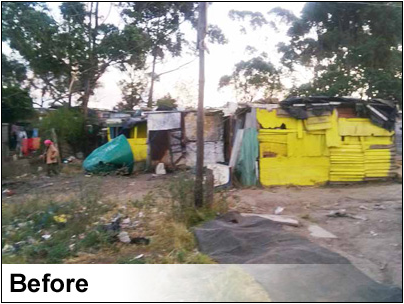 It was her explanation of how they survived that touched many South Africans. At the time she said: “I go to the dump site and dig there for food like bread. Sometimes it is full of maggots, which I shake off. We even eat rotten meat that we get from the dump site.”
It was her explanation of how they survived that touched many South Africans. At the time she said: “I go to the dump site and dig there for food like bread. Sometimes it is full of maggots, which I shake off. We even eat rotten meat that we get from the dump site.”
Back then the sound of a refuse truck making its way into Second Creek, East London signalled mealtime for residents.
Rwexu, 35, cannot remember how old she was when she moved to Second Creek but she grew up in the area. She and her family survived on what they could find at the disposal site.
It is now almost four years later and Rwexu, a mother of six, is a different person. She looks healthier, stronger and happier.
“Look at me – I’ve even gained some weight. I no longer eat rotten meat or cats. I can afford decent food like KFC,” she said.
Rwexu is still waiting for her house and is living in a shack but she is part of the group that is next on the waiting list to receive houses.
Second Creek was for the longest time not only a dumping site but also an informal settlement and home to many. Settlements such as Second Creek were formed as a result of people leaving their rural homes and flocking to cities in search of a better life.
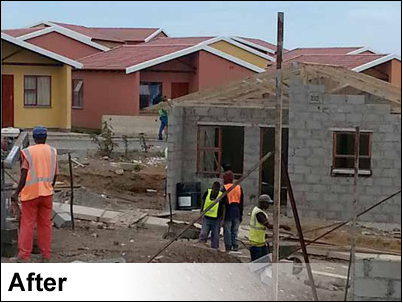 Some have lived here for more than 30 years.
Some have lived here for more than 30 years.
“Many of the people who live in the area ran away from home, some arrived with their parents who were unsuccessful at finding work. They have no family and Second Creek is the only home they know,” said Councillor Johannes Green.
When Green, who is responsible for ward 19, came into office the low-cost housing project was already underway.
The location itself is beautiful with a view of the river up to the harbour and is close to the city centre.
Before government intervened, there were almost 300 shacks in the area. There are now rows of colourful houses that residents can be proud of.
The Second Creek disposal site was cleared in 2009 and the construction of low-cost housing units started in 2013.
Today it is a huge construction site. Aside from the homes that are being built with running water, roads are being constructed and a substation was recently completed.
So far, more than 200 houses have been built and about 60 people are living in them.
“We’ve just built a substation and the installation of the towers that will supply electricity to Second Creek and surrounding areas will start soon,” said Green.
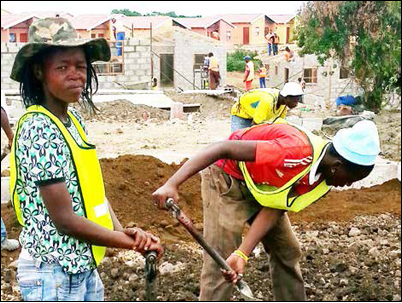 The houses are spacious with two bedrooms, an open plan kitchen and lounge, bathroom – complete with a bath, basin and toilet, and a veranda.
The houses are spacious with two bedrooms, an open plan kitchen and lounge, bathroom – complete with a bath, basin and toilet, and a veranda.
While many celebrate that government has given them shelter, some feel that their livelihood has been taken away from them and have moved to another dumping site called Berlin, also in East London.
“Before people even live in their houses, they rent them out and live in squalor. Our fear now is that more people are going to leave their houses and rent them out then move to the Berlin dump site. Then it makes it look like government is not doing anything for its people when it is,” said Lastborn Diniso, a community development worker.
Measures are in place to ensure that once shacks have been demolished only houses are built in the area.
“We don’t want any more shacks in the area,” he said.
Diniso has been involved with the project from the early stages and helped residents get identity documents (IDs), which they needed to be placed on the beneficiaries list.
The housing project also created much needed employment for the people of Second Creek. Rwexu, for example, is now able to earn an income as a supervisor on the project – she started small and worked her way up.
Rwexu is happy that government has given the residents of Second Creek homes and that life is changing for the better.
“Life has changed, our living conditions are better and living in a cleaner environment has given us a break from the flies as well,” she said.
Democracy opens doors of justice
Democracy opens doors of justice sadminSouth Africans can now take full advantage of the country’s justice system thanks to government’s initiatives to make legal services more freely available.
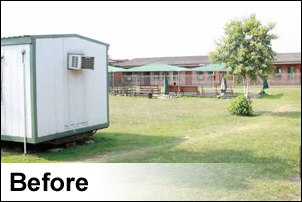 These efforts include the building of new courts, the revamping of existing ones and the re-introduction of sexual offences courts.
These efforts include the building of new courts, the revamping of existing ones and the re-introduction of sexual offences courts.
One of the challenges that the Department of Justice inherited in 1994, was the limited access to justice experienced by the poor and those in rural areas.
To address this challenge, the department has built 43 new courts. In addition, 24 branch courts have been revamped and the remaining 65 branch courts and 230 periodical courts are scheduled for rehabilitation.
Another six new courts are planned for construction over the next three years.
According to the Twenty Year Review released by the Presidency, 283 small claims courts have been established throughout the country.
“The goal is to establish one in every district. New court buildings have been built in previously disadvantaged communities,” the review adds.
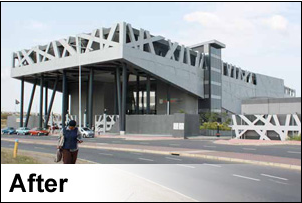 In 2013, Justice Minister Jeff Radebe announced that 22 sexual offences courts were to be re-introduced by the end of the 2014 and up to 57 sexual offences courts would be operational countrywide within in the next three years.
In 2013, Justice Minister Jeff Radebe announced that 22 sexual offences courts were to be re-introduced by the end of the 2014 and up to 57 sexual offences courts would be operational countrywide within in the next three years.
Sexual offences courts were first introduced in 1993 and by the end of 2005 there were 74 sexual offences courts countrywide. However, these courts were phased out over the years because of budget constraints but are now being re-introduced.
Over time, government has also introduced measures to ensure that those who can not afford legal representation are still able to access it. Affordable legal representation is a critical and integral part of access to justice.
“Legal Aid South Africa was established to provide legal aid services to the poor in both criminal and civil matters. It currently provides service through its 64 justice centres, 64 satellite offices and 13 High Court units, established throughout the country. These centres provide general legal advice through Legal Aid South Africa’s professional and paralegal staff,” says the review.
New courts broaden access to justice
New courts broaden access to justice sadminFor Zandile Mnguni the first two years of motherhood were bliss, with the father of her son taking care of his duties and looking after their bundle of joy.
After the arrival of her second child two years later, things took a turn for the worse for the 28-year-old.
The couple went their separate ways and after a while Mnguni’s former partner stopped providing financial support for the children.
“He stopped paying maintenance and I was not sure what to do or where to go,” she recalled.
Mnguni, from KwaMashu in KwaZulu- Natal, explained that there were times when her children, who are now six and nine, would not go to school because there was no money for transport or food.
“This really broke my heart and I felt so alone,” she said.
Ntuzuma Magistrate's Court
Then one day, as Mnguni was in a taxi to town, she noticed a new building in the area. It was the Ntuzuma Magistrate’s Court, which opened in May last year.
“The next day I made it a point to visit the court. I was hoping to get help with the problems I was having with the father of my children,” said the unemployed Mnguni.
When she arrived at the court staff directed her where she needed to go for assistance.
“I was told to come back with the documents I would need to process my claim, which included my identity document, birth certificates of my children and banking details. I was also given a form that needed to be completed by my bank.”
Mnguni returned to court and later appeared before a magistrate with the father of her children, which is when they discussed how he would pay maintenance. By October, Mnguni was receiving the maintenance money that had been agreed upon.
“I am very happy that government has given mothers this power. It’s very easy to get help from the court. This is something I was not aware of and many people in my community don’t know about it either.”
Growing up, Mnguni remembers the times her mother would go to her father’s workplace to ask for money to raise her.
“Since democracy, I am not subjected to what my mother and grandmother were subjected to. There are laws that protect us as mothers and women,” she noted.
Mnguni said the best thing about visiting the court is that it is close to her home. She has the choice of walking to it or taking a taxi at the cost of R6.
Services
The Ntuzuma Magistrate’s Court forms part of the Department of Justice and Constitutional Development’s plans to provide services to previously under serviced communities.
“Most South Africans were denied access to courts, legal services and advice during apartheid. The legal services and legal aid offered to the majority were inadequate,” notes the Twenty Year Review released by the Presidency.
According to the department, the Ntuzuma Magistrate's Court is the 43rd court to be built since 1994 and is one of the department’s new generation courts, fitted with state-of-the-art technology incorporating electronic communications, networking and data systems.
The equipment includes a digital court system for recording proceedings in active courtrooms and an audio visual remand system, which links to Correctional Services allowing for postponements and other matters via video conference. The regional and high courtrooms are fitted with CCTV equipment, two-way facilities and waiting rooms for sexual offences cases involving minors.
The new court brings justice services to the areas of Inanda, Phoenix, KwaMashu, Ntuzuma and tribal areas known as AmaQadi, Amaphephethe and Amatata.
Previously, the community of Ntuzuma received limited services in a small dilapidated court, which had a school like structure.
Since the 1970s, the Ntuzuma Court was a branch court of the Verulam Magistrate’s Court and only dealt with criminal and family court matters.
This meant that residents of Ntuzuma, KwaMashu and Inanda would travel about 20km to access additional services. The Ntuzuma Court, which was one the many branch courts countrywide, was redesignated as a full services court in October 2011.
The department invested over R200 million in the new facility, constructing a fully-fledged court building which consists of 17 courtrooms including one high court, 45 magistrates and prosecutors' offices, 19 prisoner cells and four prisoner consultation rooms.
Access to justice
According to the department, apart from the 43 new courts built over the past 20 years, 24 branch courts were revamped and elevated to proper full service courts, taking services to rural and previously disadvantaged areas. Nine justice regional offices, each with its own regional head were established from 1997. This has led to easier access and a faster response to provincial and local justice-related issues.
SA gives SAPS the thumbs up
SA gives SAPS the thumbs up sadminThe safety of all South Africans is one of government’s priorities. The South African Police Service (SAPS) is among those tasked with ensuring this safety and has made great strides in fighting crime over the past 20 years.
Although often criticised for not doing enough, many South Africans, like some of those who spoke to Vuk’uzenzele, are proud of our men and women in blue.
 Nyo Molamu
Nyo Molamu
I do feel safe in this country and I choose not to listen to the negativity. I choose to be positive and not worry about the crime rate. I think there is room for improvement within the police system but the police are trying and we all need to start somewhere.
Sue du Plessis
I have always found the police to be very helpful whenever I needed them. We have good policemen and women, who work hard. They don’t receive the best of salaries but they give their best. Police officers see a lot of bad things and need counselling too. I also think they need better salaries and working conditions. Overall, the police are moving in the right direction but a little more improvement is needed.
Thabile Tshabangu
I think the SAPS is doing a great job in maintaining public order by combating organised crime and acting against anti-social behaviour. In my township, police officers work with community members through the Community Policing Forum. The police’s role is to serve, maintain law and protects us. I feel safe enough because I think we have a well-trained police service.
Warren Gabin
There have been improvements in terms of police visibility compared to pre-1994 but more are still needed. Policing still needs to be a calling rather than a job. Our government still needs to do more to train police and implement policing policies.
SAPS striving for a safer SA
SAPS striving for a safer SA sadminIncreasing the police budget, launching a Police Academy and intensifying crime-fighting efforts are some of government’s efforts to strengthen police.
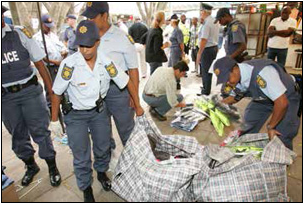 According to the 20 Year Review, before 1994, the police’s primary focus was upholding the apartheid state.
According to the 20 Year Review, before 1994, the police’s primary focus was upholding the apartheid state.
“The resulting in highly centralised, para-militarised and authoritarian police service concentrated its efforts and resources on eliminating opposition to the apartheid system,” the report notes.
By 1994, levels of crime and insecurity had increased dramatically in the absence of effective crime prevention and investigative policing services. Between 1983 and 1992, the murder rate increased by 135 per cent, robbery by 109 per cent, housebreaking by 71 per cent, car theft by 64 per cent and rape by 62 per cent.
In order to tackle the high levels of crime, under the democratic government, more skills and police officers were needed. Under democracy, funds allocated for the police to function have increased significantly.
The police budget jumped from about R6 billion in 1994 to R63 billion in 2013.
According to the review, overall reported crime rate remained stable between 1994 and 1998 before peaking in 2003 and then declining after 2003.
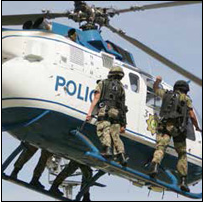 The intensity of serious crimes changed be twee n 1994/95 and 2012/13.
The intensity of serious crimes changed be twee n 1994/95 and 2012/13.
“Reduced crime levels after 2003/04 could be attributed to an increase in visible policing and improved crime-combating initiatives, which were part of the National Crime Prevention Strategy. Improvements in conviction rates and the imposition of harsher sentences could also have acted as disincentives,” it adds.
While progress has been made in achieving a more efficient criminal justice system, the review acknowledges that more needs to be done.
“Since 1994, crime detection rates have generally improved. For example, the crime detection rate for contact crimes improved from 39.5 per cent in 2001/02 to 60.7 per cent in 2011/12.
“However, a 60.7 per cent detection rate still means that many reported cases remain unresolved. This indicates that there is still much room for further improvement in detective and investigative capacity in the police force.”
Several surveys have shown that citizens and communities are beginning to feel safer.
“The Victims of Crime Survey found that over 40 per cent of households felt the levels of violent and non-violent crime had decreased in their area of residence during the period 2008 to 2010.
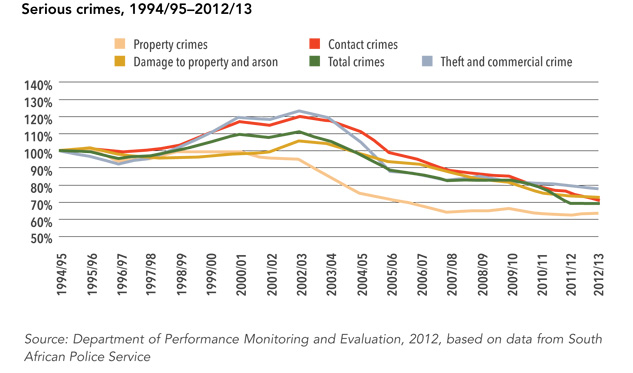 “Furthermore, about 60 per cent of households surveyed were satisfied with the way the police and courts are doing their work.”
“Furthermore, about 60 per cent of households surveyed were satisfied with the way the police and courts are doing their work.”
The South African Police Service is also on a drive to improve its image and professionalism among its ranks.
To help achieve this, Police Minister Nathi Mthethwa opened a Police Academy earlier this year.
The academy, in Paarl in the Western Cape, is a partnership between SAPS and the University of South Africa and currently has 120 students studying towards a Bachelor of Policing degree.
The academy aims to produce a new breed of police professionals equipped with the right theoretical and practical training that will help them to serve the country and its citizens diligently, efficiently and effectively.
“The academy needs to create a police service that is steeped in the values enshrined in our Constitution, that is ready to serve the citizens and is able to inspire the confidence of the ordinary person on the street. This is also underpinned in the five key priorities of the government’s programme of action,” said Minister Mthethwa.
The academy only enrols members of the SAPS who meet very strict admission requirements. Students are expected to achieve a minimum of 65 per cent to progress.
The students are being taught on a full time basis by experienced and internationally recognised staff.
New infrastructure boosts SA, economy
New infrastructure boosts SA, economy sadminGovernment is spending big on infrastructure with the aim of improving the lives of South Africans and boosting the economy.
The National Infrastructure Plan, rolled out in 2012, is geared at changing the economic landscape of the country and creating jobs. The plan is an effort by government to build new infrastructure and upgrade existing infrastructure across the country.
In 2013, Finance Minister Pravin Gordhan announced government would invest R827 billion over three years in building new and upgrading existing infrastructure.
The upgrades of the different infrastructure projects such as roads, electricity plants, ports, airports, hospitals, schools and dams will contribute to faster economic growth.
The biggest chunk of the investment in infrastructure will continue to come from Eskom’s two coal power stations, Medupi and Kusile.
Electricity infrastructure
The democratic government inherited a modern electricity generation fleet that was largely fuelled by coal and able to deliver electricity at low prices. Between 1994 and 2002, little investment was made in electricity generation.
The unexpected rapid growth of the economy after apartheid defied decades-old planning expectations in the electricity sector. Demand exceeded supply and the problem was compounded by pre-1994 decisions to stop power stations resulting in a supply crisis in early 2008.
According to the Twenty Year Review, the democratic state provided access to electricity to over 5.8 million households in less than 20 years. Under democracy electricity has become more accessible.
“In less than 20 years, the democratic state has provided access to electricity to over 5.8 million poor households. The electrification programme – which is rolled out by Eskom and municipalities and administered by the Department of Energy – has reduced the percentage of households without electricity to 14 per cent (from approximately 50 per cent in 1994),” the review notes.
Since 1994, there has been major policy reform in the electricity sector. New policies and laws were introduced to transform the sector. The most significant was establishing Eskom as a public company in 2002.
As a result of these interventions, access to electricity increased from just over 50 per cent of households in 1994/95 to 86 per cent in 2013/14.
In an effort to increase the generation of electricity and relieve the pressure on existing power stations, two new large coal-fired power stations, Medupi in Limpopo and Kusile in Mpumalanga, are under construction.
The two power stations are among the major construction projects of the democratic government.
MEDUPI Power Station
The Medupi power station is a coal-fired plant comprising six units with the ability to produce power of 800MW each.
According to the power station’s general manager Roman Crooks, this amount of power could light up most of Cape Town. Unit six is 90 per cent complete and construction for unit five has already started, he added.
The target is complete the entire project by 2018, Crooks said.
When finished, Medupi will be the world’s fourth largest coal power station and will be the largest dry-cooled power station in the world.
The construction of the power station is already making a positive impact on the small town of Lephalale as homes and social infrastructure is developed to serve the thousands of contractors working on the site.
Kusile Power Station
Kusile is a coal-fired power station close to the existing Kendal Power Station in Mpumalanga. The Kusile site is about 1 355 hectares in size and is located on the Hartbeesfontein and Klipfontein farms.
It is the most advanced coal-fired power plant project by Eskom. A coal-fired power station takes about 10 years to build, but due to capacity constraints, the Kusile project has been fast-tracked and it is anticipated that it will take about eight years to complete.
Rail infrastructure
According to the review, the use of Metrorail grew steadily from 1993 to 1999.
This growth put pressure on the passenger rail network and the system reached the limits of its capacity. This resulted in unreliability arising from old rolling stock and signal system failure due to power failures, which were mostly because of copper cable theft.
A new agency - Passenger Rail Agency of South Africa (PRASA) - was formed to specifically focus on passenger rail. The agency was given the task of managing and upgrading the old infrastructure as well as overseeing the transportation of passengers to the major economic hubs of the country.
In 2010, Prasa embarked on an ambitious plan to upgrade the infrastructure. From 2015, train commuters will be travelling in new trains with modern features such as Wi-Fi, CCTV cameras, comfortable seating, air conditioning, route maps, on-board communication and toilets.
Overcrowding, delays, crime and train surfing will be a thing of the past as commuters experience the benefits and dignity of modern travel.
This will all be thanks to PRASA’s new fleet of trains. About 3 600 trains, valued at R51 billion are expected to be delivered over a 10-year period from 2015, creating 8 088 direct jobs.
This will be the result of PRASA upgrading its rolling stock fleet. PRASA will operate the normal Metro train and the more luxurious Metro Express. Both trains will run with six carriages during off-peak hours and 12 carriages during peak hours.
Since 2010, PRASA has been stepping up efforts to improve the rail network, as well as purchase new passenger and goods trains. The new trains will be phased-in in three corridors. The first line will be from Mabopane via Pretoria and Germiston to Park Station and Naledi. The second will be the south to north corridor in KwaZulu-Natal (Umlazi, Durban and KwaMashu). The third will be the Cape Town to Philippi route in the Western Cape.
Gautrain
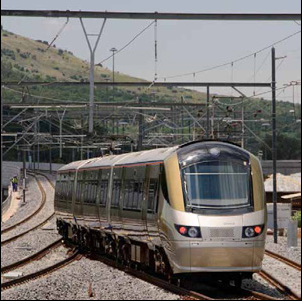 In an effort to reduce the traffic congestion between the Johannesburg and Pretoria route, government undertook the ambitious project of constructing a high-speed train service in Gauteng – the Gautrain.
In an effort to reduce the traffic congestion between the Johannesburg and Pretoria route, government undertook the ambitious project of constructing a high-speed train service in Gauteng – the Gautrain.
The construction phase of the project started in 2006 and was completed in 2011.
The Gautrain provides a link between Johannesburg, Pretoria and OR Tambo International Airport and transports over 1.2 million passengers monthly between 10 stations.
The Gautrain also runs a feeder bus service operating on a 125km range in Gauteng. The construction phase of the project played an important role in creating jobs and providing training for skilled and semi-skilled personnel.
The number of direct jobs created amounted to 11 700, while 63 200 indirect jobs were created and 10 400 skilled and semi-skilled personnel were trained. In addition 1 250 courses were offered for management.
Bus Rapid Transit
The City of Johannesburg has taken the lead by implementing its bus rapid system.
The Bus Rapid Transit or ‘Rea Vaya’, as the service is commonly known, was constructed to improve public transport in and around the city, reduce congestion on public roads, improve the environment and create jobs.
While providing safe, affordable and reliable public transport, the BRT has also created more than 7 000 jobs since it was initiated in 2009.
“Every day 40 000 passengers are transported safely, affordably and reliably. There has been significant skills transfer to construction workers, bus drivers and also to 400 station staff including ambassadors, marshals and cashiers,” says the executive director of transport at the City of Johannesburg Lisa Seftel.
The long-term plan is for Rea Vaya routes to cover 330km, allowing more than 80 per cent of Johannesburg residents to catch a bus.
Gautrain makes commuting a breeze
Gautrain makes commuting a breeze sadminFor nearly two years, IT consultant Atisang Nko has been enjoying the benefits of government’s investment in new transport infrastructure by using the Gautrain.
He travels on the Gautrain from Pretoria to Midrand and says the train is always on time despite one or two glitches, especially on rainy days.
Like many other Gautrain users, Nko’s main gripe with the service is the overcrowding, especially during peak times.
“Trains and buses are usually packed during peak hours, which can be a strain. Perhaps trains can be increased by maybe two carts to alleviate the overcrowding,” he suggests.
According to Nko, the Gautrain service is user friendly, affordable and convenient as he walks for less than 20 minutes from his flat to the Pretoria station.
Spokesperson for the Gautrain Dr Barbara Jensen says most passengers are happy with the service.
“The system is still popular for its efficiency and affordability.”
She says if the overcrowding continues, more trains will be added.
“Demand patterns and crowding on trains are monitored continuously. If certain norms or thresholds are transgressed over a period, additional rail service capacity has to be introduced. “At present an additional eight-car train is planned to be introduced in the morning peak period. This will be done as soon as the demand patterns are confirmed.”
Plans to extend the hours for the airport link are also underway.
“Discussion to extend the airport link hours is at a developed phase. In the future there will be an earlier train in the morning and later in the evening,” Jensen adds.
Medupi Legacy Project empowers Lephalale
Medupi Legacy Project empowers Lephalale sadminThe Medupi power station will be world’s fourth largest coal power station and will be the largest dry-cooled power station in the world.
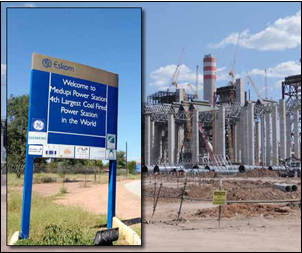 But residents of Lephalale don’t have to wait for the completion of the project to enjoy the benefits of having a power station of this magnitude in their town.
But residents of Lephalale don’t have to wait for the completion of the project to enjoy the benefits of having a power station of this magnitude in their town.
The Medupi Legacy Project is already leaving a lasting legacy and making a difference in the lives of people in and around Lephalale.
As part of its corporate social responsibility initiatives, Eskom introduced the Medupi Legacy Project, which is empowering Medupi employees and the people of Lephalale.
Elements of the project include financial literacy courses, further education and training courses and small, medium and micro enterprise skills development. With regards to enterprise development, Eskom identifies potential local contractors and provides them with the knowledge they need to set up and develop their own businesses.
So far, the programme has trained approximately 3 000 employees in various trades such as boiler making, coded welding and engineering.
The aim of the programme is to have a large number of skilled people who are employable within the Lephalale municipal areas after the construction of Medupi is complete.
Medupi’s general manager Roman Crooks says the programme has created sustainable livelihoods for the locals.
“It is part of our policy and strategy as Eskom to create a sustainable foundation for the locals. We don't do things for people, we do it with them and we believe equipping businesses with the necessary knowledge to compete successfully in the business world will have a ripple effect on South Africa’s economy.”
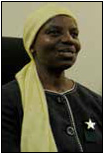 One of the beneficiaries of the programme is Mumsy Swanepoel. She attended Eskom’s eight month long course designed to equip locals with skills to open their own businesses.
One of the beneficiaries of the programme is Mumsy Swanepoel. She attended Eskom’s eight month long course designed to equip locals with skills to open their own businesses.
"The course was fantastic. I thoroughly enjoyed it and I now apply what I learnt on a daily basis in my business. With the knowledge I gained, I am now running my business professionally and efficiently and it has also helped me secure more contracts than ever before,” says Swanepoel.
She owns and runs a security company, guesthouse and lodge that provides accommodation for Eskom employees.
Her businesses employ 750 people from Lephalale, White River and Bushbuckridge. As a beneficiary of a skills development programme, Swanepoel has pledged to send some of her employees on training programmes. So far, four of her employees have undergone training in human resources and attended managerial courses.
Rea Vaya drives away travel blues
Rea Vaya drives away travel blues sadminGone are the days when Tisetso Masilela, of Soweto, would have to put up with traffic on her way to work. Like many commuters f rom townships neighbouring big cities like Johannesburg, Pretoria and Durban, Masilela would arrive at work late as a result of the traffic congestion leading into the city centre.
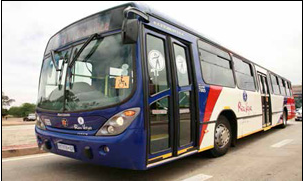 A Bus Rapid Transit system feasibility study was carried out in 2006, which noted the importance of building new infrastructure to ease traffic congestion in and around Johannesburg.
A Bus Rapid Transit system feasibility study was carried out in 2006, which noted the importance of building new infrastructure to ease traffic congestion in and around Johannesburg.
Work on the system started in 2009, with the aim of providing safe, affordable and reliable public transport.
With the construction of the Bus Rapid System (BRT) or Rea Vaya in Johannesburg, Masilela says getting to and from work is easy and less frustrating.
She has been using the BRT since 2011 and is happy with the service. “I find it reasonable. It’s safe and saves time because the buses use their own lanes. It is also affordable,” she says.
Living close to the bus station also saves Masilela from having to put up with a long walk in the mornings and evenings.
“I’m not far from the main station and there is a feeder station close to my house so I don’t have any problems accessing the bus in the morning and afternoon,” she adds.
Masilela says since it started, the service has improved. “BRT has now grown compared to when it started. There are more stations open as well as more buses and routes in place. There is a lot of improvement in terms of the routes.”
The only challenge she has faced is poor communication between the commuters and the management of BRT.
“The staff need to update the commuters when the buses are delayed. I also think the drivers and other staff need to undergo some customer service training, Masilela adds.
What it took to grow SA’s economy
What it took to grow SA’s economy sadminFrom a virtually bankrupt state to a thriving trillion rand budget, South Africa’s economy is undoubtedly a world away from what it was 20 years ago.
A declining employment rate, low investment levels, a poorly educated workforce and large monopolies - these were the features that characterised the South African economy in the period leading to 1994.
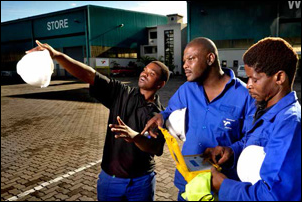 Despite the apartheid government’s efforts to hide all its human rights abuses from the international community, the 1990s saw investors and trade partners pulling out of South Africa in numbers.
Despite the apartheid government’s efforts to hide all its human rights abuses from the international community, the 1990s saw investors and trade partners pulling out of South Africa in numbers.
With devastating internal revolt, sanctions and economic isolation in the lead up to the 1994 historic elections, it was a forgone conclusion that the first democratic government of South Africa was to inherit an economy in crisis.
And that is exactly what happened when the late former President Nelson Mandela was inaugurated as the country’s first democratic president.
According to the Twenty Year Review, the economy grew by just over 1 per cent a year between 1980 and 1994. The poor state of the economy was inevitably going to be a huge challenge for any government that had to meet the expectations of millions of people who were marginalised for over three centuries.
Looking back at 1994, it’s hard to believe how much South Africa’s economy has grown.
Today, millions of South Africans have jobs and are able to access basic services such as water and sanitation and social grants are reaching about 16 million people in need of assistance.
South Africa is now ranked by the World Bank as an “upper middle-income country” and has earned its position as the largest economy in Africa. The review reveals that by 2012, the GDP had reached US$ 384 billion (about R4.1 trillion) compared to the US$ 136 billion in 1994 (about R 1.4 trillion).
Recovery in investment
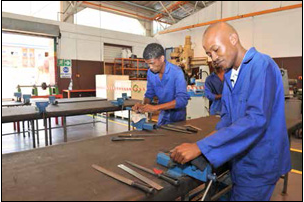 The review attributes growth and strength in the South African economy to the reconfiguration of institutions such as South African Revenue Services, the South African Reserve Bank, the Competition Commission and the National Economic Development and Labour Council. South Africa emerged from the pre- 94 economic crisis to attain macro-economic stability – a key achievement of the democratic government.
The review attributes growth and strength in the South African economy to the reconfiguration of institutions such as South African Revenue Services, the South African Reserve Bank, the Competition Commission and the National Economic Development and Labour Council. South Africa emerged from the pre- 94 economic crisis to attain macro-economic stability – a key achievement of the democratic government.
The review notes that work done under the three democratic administrations from that of President Mandela, his successor President Thabo Mbeki to President Zuma – saw the South African economy grow at 3.2 per cent a year on average from 1994 to 2012.
There were only four quarters of negative growth between 1994 and 2012, a far lower rate than in the years before democracy.
While investment must be between 20 per cent and 25 per cent of GDP to sustain growth, it went up from 15 per cent in 1993 to reach 24.8 per cent of GDP in the fourth quarter of 2008 – just before the recession.
Economic policies
The review notes that the new administration in 1994 had to adopt certain policies aimed at stabilising and transforming the economy.
Policy documents included the Ready to Govern and Reconstruction and Development Programme, both aimed at tackling the triple threats to the economy – unemployment, poverty and inequality.
The RDP aimed to address socio-economic needs and restore dignity to the poor.
This programme was aimed at the immediate needs of the people – from the provision of housing, distribution of clean water, electrification of communities, social infrastructure like health care and land reform, among others.
But authorities said that would not be enough to redress the decades-long structural inequalities that apartheid and its laws had created. Government had to introduce the Black Economic Empowerment (BEE) programme to allow more black people to be players in the mainstream economy.
BEE has since been expanded to Broad-Based Black Economic Empowerment to introduce interventions that would promote employment preference, skills development, ownership, management, socio-economic development and preferential procurement.
Looking ahead
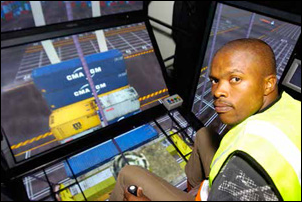 The National Development Plan, supported by the New Growth Path and the Industrial Policy Action Plan, sets out what still needs to be done to achieve sustainable economic transformation. Key actions include:
The National Development Plan, supported by the New Growth Path and the Industrial Policy Action Plan, sets out what still needs to be done to achieve sustainable economic transformation. Key actions include:
- Maintaining large-scale but sustainable public investment in infrastructure to facilitate economic growth, with improved maintenance and a well-defined financing strategy.
- Improving the quality of basic education and expanding higher and further education, linked to stronger ties between enterprises and Further Education and Training in particular, to provide the skills required by a growing economy.
- Ensuring that regulations are implemented as efficiently and cost-effectively as possible, without imposing unnecessary delays or red tape to create a businessfriendly environment.
- Continuing to increase financing for industrial development and small and micro enterprise in the context of a strong industrial policy focused on bolstering employment and growth.
- Improving energy security including through development of shale gas, while continuing to take advantage of opportunities and minimise the costs from greening the economy.
- Enhancing regional development through increased investment in logistics, combined with the establishment of regional value chains, to facilitate regional economic growth and integration.
- Stronger measures to address workplace conflict by working with stakeholders to address unfair inequalities and improve communication and career development to create a more stable workplace environment for growth.
The NDP further states that it is only through effective partnerships across society that a good cycle of rising confidence, rising investment, higher employment, and increased productivity and income can be achieved.
This requires greater trust between the state, labour and business.
Women, people with disabilities empowered
Women, people with disabilities empowered sadminBefore 1994, apartheid, colonialism, cultural and religious practices in South Africa promoted the oppression of women.
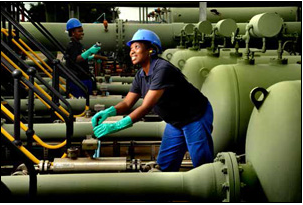 According to the Twenty Year Review, the apartheid regime reinforced discrimination based on gender and introduced policies and laws that oppressed women.
According to the Twenty Year Review, the apartheid regime reinforced discrimination based on gender and introduced policies and laws that oppressed women.
Fast forward to 2014, South African women are in a better position than they were in before 1994 and they have a good story to tell. One element of that story is the positions held by women in provincial and national government and the public service.
“Overall, national and provincial government combined employed 1.3 million people by the end of 2011/12. Of these, 57 per cent were female and 43 per cent male. Furthermore, 80 per cent were African, 9 per cent white, 8 per cent coloured and 3 per cent Asian,” the review adds.
Currently, out of the nine premiers five are women, outnumbering their male counterparts.
Women have also made progress in other areas.
“Before 1994, women were mainly confined to magistrate positions in the judiciary. No black woman held a judge position. Since 1994 there have been increasing numbers of women judges in the judiciary, with two women occupying seats at the Constitutional Court.
“However, in the private sector, the country remains challenged by the relatively low representation of women in corporate boards and as chairs and CEOs,” reads the review.
South African women have also been appointed to leadership positions across the world.
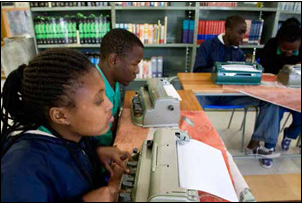 Former Minister of Home Affairs Nkosazana Dlamini Zuma is currently flying the South African flag as the African Union Commission Chairperson while former Deputy President Phumzile Mlambo-Ngcuka is the current Executive Director of UN Women.
Former Minister of Home Affairs Nkosazana Dlamini Zuma is currently flying the South African flag as the African Union Commission Chairperson while former Deputy President Phumzile Mlambo-Ngcuka is the current Executive Director of UN Women.
Locally, women are also benefiting from increased access to basic services at a household level, which is having a positive outcome on their families.
“Before 1994, women were not allowed to legally buy or own a home and land. The amended Divorce Act protects women’s property rights in cases of divorce and the amended Customary Marriage Act (2000) recognises customary marriages in favour of women, especially with regards to inheritance. Women are now also able to obtain a mortgage,” according to the review.
Government took women’s issues seriously from as back as 1997 by establishing institutions to promote gender equality. Three years into democracy, government established Office on the Status of Women (OSW) and in the same year Parliament passed legislation to establish the Commission on Gender Equality (CGE).
The commission was established as one of the Chapter 9 institutions with the responsibility to monitor, evaluate research, investigate complaints and conduct public awareness and education on women’s rights and gender quality.
The commission also aims to transform society by “exposing gender discrimination in laws, policies and practices; advocating changes in sexist attitudes and gender stereotypes; and instilling respect for women's rights as human rights”.
Although the commission acts in the interests of women generally, it pays particular attention to the most disadvantaged women, those living in rural and peri-urban areas, on farms and in domestic work.
People with disabilities
Over 20 years ago, democratic South Africa, inherited a society with widespread ignorance and prejudice towards people with disabilities.
People with disabilities faced a number of obstacles in accessing basic services, with facilities such as schools and places of employment separating children and adults with disabilities from their peers.
“During the pre-1994 negotiation process, it was agreed that self-representation - the right of disabled people to speak for themselves in all matters affecting their lives, and mainstreaming disability across government machinery – were non-negotiable,” the review notes.
The Integrated National Disability Strategy in 1997, proved to be a historical milestone in the fight to promote the rights of people with disabilities by guiding the formulation of policies and programmes aimed at advancing their rights.
Services ranging from free health care, social assistance and inclusive education, targeting both adults and children with disabilities, opened up access to opportunities. In 2009, President Jacob Zuma announced that a new department would be established. During that announcement, he emphasised the need for equity and access to development opportunities for the vulnerable groups in our society.
The announcement gave birth to the Department of Women, Children and People with Disabilities.
The department was given the mandate of promoting, facilitating, coordinating and monitoring the realisation of the rights of women, children and people with disabilities.
Government has also made strides in making access to education for children with disabilities a reality. “Access to special schools for children with disabilities has improved, with the number of public special schools increasing from 375 to 423 from 2002–2011,” notes the review.
Though progress has been made, a large percentage of children with disabilities are still not accessing formal education, either through special schools or mainstream education.
Progress has also been made in the workplace.
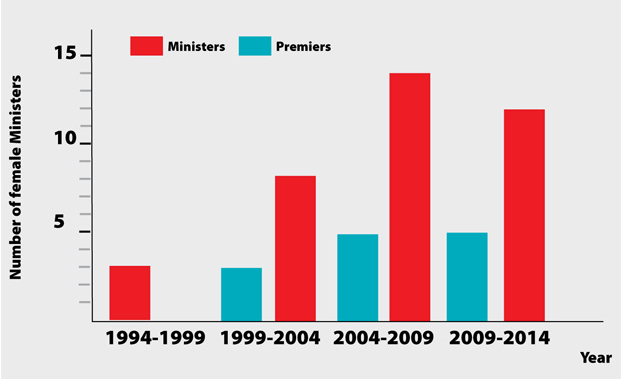 “In the workplace, employment equity and protection of workers from an unsafe work environment that could lead to illness and disability is ensured through effective legislation.
“In the workplace, employment equity and protection of workers from an unsafe work environment that could lead to illness and disability is ensured through effective legislation.
“Access to learnership programmes targeting youth with disabilities has promoted skills development and further raised awareness of disability,” explains the review.
While major strides have been made to include people with disabilities in the mainstream, much still remains to be done to address discriminatory attitudes, inaccessible public transport systems, barriers in the built environment that may prevent people with disabilities from accessing services, lack of access to communication and information, as well as poor enforcement of key legislation impacting on disability.
To address these challenges, the NDP includes plans to increase access to services, particularly quality education and employment, for people with disabilities.
Vulnerable groups
To address children’s vulnerability, the democratic state is focusing on improving the poor living conditions and inequalities experienced by the majority of children marginalised by apartheid policies.
“In collaboration with civil society, the state and civil society have introduced programmes focusing on children’s rights to health, nutrition, early childhood development, education, and safety and protection,” says the review.
It also notes a reduction in child poverty. “Consequently, there has been a reduction in child poverty as well as an improvement in the living conditions of black, rural and girl children, and children living in poverty.”
Opportunities for SA youth on the rise
Opportunities for SA youth on the rise sadmin“Education, skills development and job creation are the most powerful weapons that the youth will need to enable them to run the country's modern economy efficiently.”
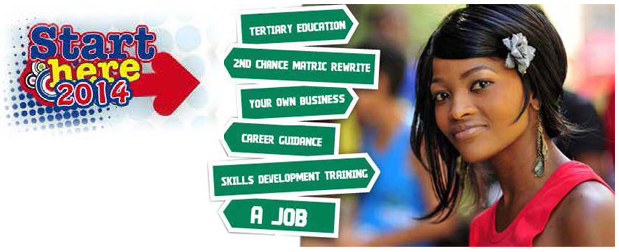 This is the view of President Jacob Zuma, who recently spoke about the importance of the country’s youth during the recent inaugural Presidential Indaba on Youth Jobs and Skills.
This is the view of President Jacob Zuma, who recently spoke about the importance of the country’s youth during the recent inaugural Presidential Indaba on Youth Jobs and Skills.
With over 50 per cent of the country’s population under the age of 39 and just over a third under 15, South Africa is a youthful country.
According to the Twenty Year Review, one of the priorities of government since democracy has been youth development.
In 1996 government established the National Youth Commission (NYC) and the Umsobomvu Youth Fund (UYF) in 2001.
These two initiatives focused on skills development, job creation and small business development for young people.
In 2009, the two organisations merged and on 16 June, President Zuma launched the National Youth Development Agency (NYDA). The NYDA was created to tackle the challenges that face the country’s youth.
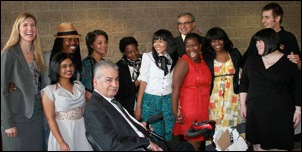 According to the NYDA, these challenges include poverty, inequality, unemployment and poor health. To address these, in May 2013, the NYDA shifted its focus to education and skills development.
According to the NYDA, these challenges include poverty, inequality, unemployment and poor health. To address these, in May 2013, the NYDA shifted its focus to education and skills development.
The NYDA says there are about 2.8 million young people who are unemployed and not furthering their studies.
“These young people remain on the margins of society and are vulnerable to social risks such as violence, crime and substance abuse,” the review notes.
One of the major challenges facing the youth is the high teenage pregnancy and dropout rate among 14 to 17 year olds.
“This has a tremendous impact on the life opportunities of young people and their ability to participate meaningfully in the economy either through employment of self-employment,” the review says.
Government has introduced many initiatives to address the challenge of youth unemployment and increase education and training opportunities for the youth. These include learnerships and internships, employment assistance services and entrepreneurial programmes.
Youth Employment Accord
During the recent Indaba on Youth Jobs and Skills, President Zuma said that the country reached an important milestone when the Youth Employment Accord was signed by youth leaders, business, labour, government and the community sector in April last year.
In less than a year since the adoption of the accord, youth employment increased strongly. To date 420 000 new jobs have been created in the construction industry under the country’s National Infrastructure Plan.
Gauteng accounted for about half of the new youth jobs, with 210 000 new jobs registered in the province. To date Gauteng has also spent about R120 million on youth enterprises. The Youth Employment Accord has also promoted the creation of internship opportunities for the youth in national departments, municipalities and state-owned enterprises.
NSC 2nd Chance Programme
With the focus on furthering education, the NYDA together with the Education Training Development Practitioner Sector Education Training Authority (ETDP SETA) launched the National Senior Certificate (NSC) 2nd Chance Programme in 2011.
The programme gives hope to those who did not pass their matric exams. According to the NYDA, as part of the programme 4 500 young people will rewrite their Grade 12 exams at the end of 2014. The programme started in 2011 when 2 039 learners enrolled. By 2013 that figure had grown to 3 168. The pass rate for these learners has also improved from 47 per cent in 2011 to 77 per cent in 2013.
This year the ETDP SETA contributed R3.6 million to fund 1 500 youth and the NYDA contributed R7 million towards the remaining 3 000 youth. As part of the programme, learners receive tuition, career guidance and job preparedness training. The main objective is to give young people who failed matric, a second chance to obtain their National Senior Certificate.
Young Entrepreneurs Programme
Building and developing entrepreneurial skills is a key element in tackling youth unemployment. Over one hundred youth have benefited from the Young Entrepreneurs Programme (YEP) since it began in 2009. The programme facilitated by the NYDA and the International Business Association (IBA) sees local business owner travel overseas for six weeks of business mentorship training.
Through the training, these youth acquire skills and learn business theory through workshops and lectures from top international entrepreneurs in the USA, Germany, Italy and Spain - giving them the skills they need to grow their businesses.
NYDA chairperson Yershen Pillay says the annual programme encourages entrepreneurship development, promotes employment opportunities and develops skills, which could address the high rate of unemployment among South African youth.
Start Here Campaign
Thousands of youth have already benefited from the NYDA’s annual Start Here Campaign - a career guidance programme, aimed at helping young people access reliable and up-to-date information to make informed decisions about their lives and futures.
The initiative forms part of the NYDA’s broader Back to School programme and is one area of the agency’s new focus on education and skills development as a tool to reduce unemployment among South Africa’s youth.
This year, the campaign stepped up its efforts and also launched a new NYDA Career Guidance booklet, which was distributed to schools nationally. The improved booklet is an updated version of the NYDA’s career guidance instruction tool used by practitioners in schools nationwide. It provides information aimed at Grade 9 learners focusing on subject choices; Grade 10, 11 and 12 learners with an emphasis on further education opportunities and outof- school youth, giving information on job hunting and entrepreneurship.
To date R3.1 million has been allocated by the NYDA to career guidance programmes annually while additional funding has been secured through a partnership with the Manufacturing, Engineering and Related Services Seta (Merseta). So far 533 186 young people have received group career guidance support from the NYDA and the target to ensure that at least 700 000 youth access career guidance support by this year.
According to Pillay, career guidance is crucial in shaping a young person’s career. “Without adequate information and direction, young people often make the wrong subject or qualification choices which lead to inevitable failures later on in life. We have dedicated this years’ Back to School programmes to our former president and icon Nelson Mandela, in line with Madiba’s passion for education.
“We must reiterate his sentiments that education is the most powerful weapon we can use to change the world. We hope to transform the lives of young South Africans through such initiates in the hope of a better life for all,” he added.
South Africa in the global arena
South Africa in the global arena sadminFormer President Mandela once described apartheid South Africa as the “skunk of the world” that was diplomatically, economically and culturally isolated from the rest.
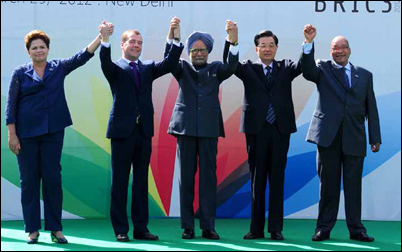 Angola, Botswana, Lesotho, Mozambique, Swaziland, Tanzania, Zambia and Zimbabwe, together with other African countries, had opposed apartheid and actively campaigned for the isolation of the apartheid state. Economic cooperation with the rest of the continent was severely limited.
Angola, Botswana, Lesotho, Mozambique, Swaziland, Tanzania, Zambia and Zimbabwe, together with other African countries, had opposed apartheid and actively campaigned for the isolation of the apartheid state. Economic cooperation with the rest of the continent was severely limited.
Developments since 1994
After the dawn of democracy in 1994, South Africa worked hard to reposition itself in the region, on the continent and in the world, with a shared interest in peace, stability and prosperity. To date the values enshrined in the Constitution, including equality, nonracialism, non-discrimination, liberty, peace and democracy, are central to South Africa’s national identity and find expression in the country’s foreign policy.
South Africa had to demonstrate to its own people and to the world that its democracy would be stable, that it would work to uplift the poor and redress past injustices at home, and that it would be a responsible member of the international community.
Inspired by the concept of Ubuntu, South Africa’s foreign policy approach was characterised by cooperation, collaboration and the building of partnerships rather than conflict and competition.
The country is now a respected member of the international community and has enjoyed successes in furthering its own interests, as well as those of the African continent and the Southern African Development Community (SADC) region.
South Africa’s reintegration into the global community has seen its diplomatic, political and economic relations increase rapidly to include countries with which it previously had no relations.
By 2012, the number of foreign diplomatic missions, consulates-general, consulates and international organisations in South Africa had increased to 315. This is the second-largest number of diplomatic offices accredited to any country after the USA. South Africa’s missions abroad increased from 36 in 1994 to 125 in 2012.
South Africa contributed to two tangible elements of the African renaissance during the first decade: the transformation of the continental political architecture with the transition from the Organisation of African Unity (OAU) to the African Union (AU) and the adoption of the New Partnership for Africa’s Development (Nepad) as the social development blueprint for Africa and the framework for its engagement with the north and other international actors.
In the second decade, operationalisation of the AU and implementation of Nepad became key focus areas, including, in particular, improving the climate for development and investment in Africa.
Acting together with its African partners, South Africa used its engagement with the Group of Eight (G8) countries to ensure the adoption of an Africa Action Plan as the framework for the G8’s partnership with the continent.
Strengthening the AU
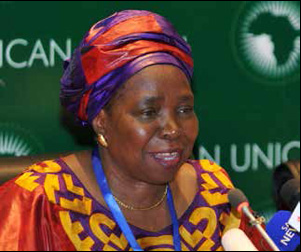 South Africa joined the OAU in 1994 and chaired the AU from June 2002 to June 2003. As the chair, South Africa played an important part in the formation of the AU’s institutions, policies and procedures, including the creation of the Pan-African Parliament and the AU Peace and Security Council.
South Africa joined the OAU in 1994 and chaired the AU from June 2002 to June 2003. As the chair, South Africa played an important part in the formation of the AU’s institutions, policies and procedures, including the creation of the Pan-African Parliament and the AU Peace and Security Council.
Pursuing the African Agenda required establishing and strengthening bilateral relations with almost all African countries.
In July 2012, former South African Home Affairs Minister Dr Nkosazana Dlamini Zuma was appointed as the AU Commission’s chairperson, to pursue for greater internal efficiency and effectiveness within the AU Commission as an executing agency of the AU collective.
The importance of Africa in South Africa’s foreign policy is reflected in the growth of South African representation in Africa, which increased from 17 in 1994 to the current total of 47 missions.
African Peer Review Mechanism
Founded in 2003, the African Peer Review Mechanism (APRM) aims to promote and reinforce high standards of governance through periodic reviews of progress towards achieving mutually agreed goals in the following focus areas: democracy and political governance, economic governance, corporate governance and socio-economic development.
In 2011, South Africa submitted its second report on the implementation of South Africa’s APRM Programme of Action (PoA). The report focused on the recommendations contained in the first Country Review Report of 2007, issued by the heads of state and governments of participating countries in the APRM and the resulting National PoA.
South Africa’s third report was submitted in January 2014 at the 22nd AU Heads of State or Government in Addis Ababa, Ethiopia. The country was praised for a number of best practices such as the use of provincial executive councils, the financial management system and the tax collection system.
SADC, regional integration
South Africa has sought to nurture regional integration at three levels: SADC, the Southern African Customs Union (SACU) and the Tripartite Free Trade Area (TFTA) between the Common Market for Eastern and Southern Africa, the East African Community and SADC. The TFTA seeks to combine the three major regional economic communities as building blocks towards continental integration and could contribute to economies of scale, the building of new distribution channels, value addition and manufacturing in Africa.
South-south cooperation
South Africa regards the valued partnership with countries of the global south as being important for the development of the country and the continent, and for creating solidarity in the global struggle against poverty, underdevelopment and the marginalisation of emerging economies.
To strengthen ties with other developing countries, South Africa has joined the following structures:
• Non-Aligned Movement (NAM).
• Group of 77 and China.
• Indian Ocean Rim Association for Regional Cooperation.
• New Asian-African Strategic Partnership.
• India-Brazil-South Africa Partnership Forum (IBSA).
• Brazil, Russia, India, China and South Africa (BRICS) Intergovernmental Forum.
BRICS
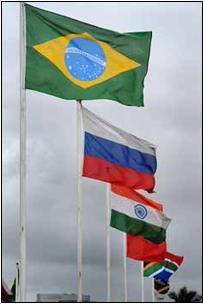 South Africa identified with the BRIC agenda of global reform and cooperation within the developing world, and joined the forum in 2011. Its invitation to join the BRIC grouping was recognition of the country’s contribution in shaping the socio-economic regeneration of Africa, as well as its active involvement in peace and reconstruction efforts on the continent and the responsible role that South Africa has been playing in the international community.
South Africa identified with the BRIC agenda of global reform and cooperation within the developing world, and joined the forum in 2011. Its invitation to join the BRIC grouping was recognition of the country’s contribution in shaping the socio-economic regeneration of Africa, as well as its active involvement in peace and reconstruction efforts on the continent and the responsible role that South Africa has been playing in the international community.
South Africa’s standing in BRICS and other groupings indicates that the country is regarded as a significant emerging power, worthy of attention in global decision-making. In 2011, South Africa ensured that infrastructure development and industrialisation in Africa was on the agenda at the BRICS summit in Sanya, China.
In March 2013, the country hosted the fifth BRICS Summit and for the first time invited African regional leaders to an inclusive BRICSAfrican Leaders dialogue on infrastructure development. The summit established a BRICS-led development bank for infrastructure and sustainable development projects in BRICS and other developing countries. Agreements have been signed under the auspices of the BRICS Interbank Cooperation Mechanism to provide, proposals for extending credit to member countries in their local currencies.
Other countries of the South
Since democracy, South Africa’s relations with countries in the Americas – specifically Argentina, Brazil, Colombia, Mexico and Venezuela – have strengthened. Relations with Turkey and key Gulf states have also improved.
Relations in southeast and east Asia have focused on China, Indonesia, Singapore, South Korea, Thailand and Vietnam, while south-Asian relations have primarily focused on Bangladesh and Pakistan. Relations with countries in Euro-Asia have developed a strong trade element.
As the National Development Plan (NDP) states, South Africa has considerable mineral resources, highly developed banking, financial, communications and transportation networks, and established and relatively successful business, industrial, mining and research institutions.
These resources could be critical for negotiating within BRICS and the world. For example, it could play an important role in facilitating trade and investment between Africa and Asia, maximising Asia’s interest in the country and the continent’s mineral resources, while promoting its own highly developed financial system.
North-South cooperation
Since 1994, South Africa has aimed to improve North-South relations, focusing on reforming the global economy and global governance, enhancing market access for developing countries and instituting more favourable terms for trade, debt relief and new forms of partnership for development.
During its first decade of freedom, the country was largely successful in engaging the G8 and the Organisation of Economic Cooperation and Development (OECD) to strengthen its economic relations with key countries and the European Union (EU). As a result, trade with the north has grown consistently and remains strong, despite the effects of the global economic crisis.
OECD
In 2007, the Organisation of Economic Cooperation and Development Ministerial Council gave South Africa and other BRICS states “enhanced engagement” status in recognition of their global significance. Until this point, South Africa had been an observer.
European Union
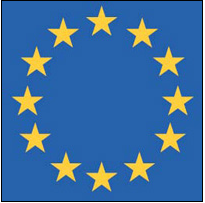 Bilateral relations with South Africa’s traditional partners in Western Europe have remained strong and expanded since 1994, notably with the United Kingdom, Germany, the Netherlands, France, Italy and the Nordic countries.
Bilateral relations with South Africa’s traditional partners in Western Europe have remained strong and expanded since 1994, notably with the United Kingdom, Germany, the Netherlands, France, Italy and the Nordic countries.
The Trade and Development Cooperation Agreement (TDCA), which entered into force in May 2004, is the overall agreement that regulates the relationship between South Africa and the 28 member EU. The TDCA provides for a Free Trade Area and dialogues at Senior Official, Ministerial and Presidential/Summit level. In addition to the TDCA, South Africa has signed a Science and Technology Agreement (STA) and a Wines and Spirits Agreement with the EU.
South Africa is the only country in Africa that enjoys such a strategic partnership with the EU. By 2009, South Africa was the EU’s 14th largest trade partner and the second-largest from Africa. Various trade agreements are also in place between South Africa, the EU and regional economic groupings. South Africa was a member of an AU group that engaged the EU on an EU-Africa strategy, which was adopted in 2007.
Despite the international economic crisis that impacted negatively on Western Europe, countries in the region remained South Africa’s leading partners in areas such as trade, investment and tourism.
Many of these countries are committed to supporting government priorities such as boosting employment, skills-enhancement and vocational education programmes. Europe remains a leading continent in terms of scientific, technological and pharmaceutical research and capacity, in which the country has found valuable bilateral partnerships.
African multilateral partnerships
The various African multilateral partnerships in which South Africa has played an important role since 1994 aim to strengthen the continent’s human capacity and productive bases by diversifying economies and attracting investment.
These partnerships have refocused the world’s attention on Africa’s potential and its challenges. They have enabled the mobilisation of resources to address Africa’s development objectives. The various partnerships also afford Africa the opportunity to solicit the necessary training, capacity-building, infrastructure and financial resources to implement key AU-endorsed priority continental projects and programmes, including aiming to achieve the vision, objectives and goals of Nepad.
Institutions of global governance
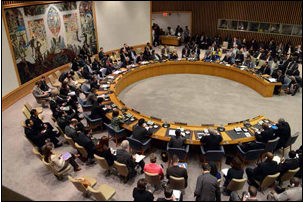 South Africa’s foreign policy has traditionally placed the UN at the centre of the multilateral system. In collaboration with its global partners, the country has consistently continued to engage the north on reforming global economic rules through the World Bank, the International Monetary Fund, the World Trade Organisation and the United Nations Conference on Trade and Development.
South Africa’s foreign policy has traditionally placed the UN at the centre of the multilateral system. In collaboration with its global partners, the country has consistently continued to engage the north on reforming global economic rules through the World Bank, the International Monetary Fund, the World Trade Organisation and the United Nations Conference on Trade and Development.
The country’s constructive role in global governance structures, as well as its position within organisations such as the AU, the NAM and the G77 and China contributed to a positive perception of South Africa’s global profile by BRICS and other like-minded partners.
The international community entrusted South Africa with hosting and presiding over COP17/CMP7 in Durban, at a critical time in the global climate-change debate. This conference resulted in the Durban Outcome, which has been hailed internationally for restoring trust in the UN climate-change process. South Africa has also hosted other international conferences and meetings under the auspices of the UN.
In 2002, the country hosted the World Summit on Sustainable Development where it advocated for an action-orientated outcome with a set of targets for sustainable development. These efforts resulted in the adoption of the Johannesburg Plan of Implementation, which gave content to the Agenda 21, the UN plan on sustainable development.
Peace, security and stability The AU has expressed its commitment to not recognise unconstitutional changes in government and to develop its own African Standby Force (ASF) to intervene in conflict situations. South Africa played a critical role in the establishment of the African Capacity for Immediate Response to Crises at the AU Summit of May 2013, as an interim measure towards the establishment of a permanent ASF.
Contributing to peace, stability and postconflict transition in Africa has been integral to South Africa’s post-apartheid policy. Since 1994, the country has earned a reputation for being an accomplished mediator, with successive presidents playing key roles in negotiating settlements elsewhere in Africa, such as in Madagascar, Sudan and Zimbabwe.
Through its role in SADC, South Africa mediated in Madagascar after a 2009 coup, helping to secure an agreement to lead Madagascar out of crisis. This culminated in Madagascar holding a referendum in 2010 and elections in October 2013. Closer to home, South Africa was the SADC-mandated facilitator in Zimbabwe. Its efforts contributed to Zimbabwe adopting a new constitution in March 2013, laying the basis for credible elections, which were held in July 2013.
In 2013, South Africa contributed troops, together with the Republic of Malawi and the United Republic of Tanzania, to the SADC-led Intervention Brigade in the Eastern Democratic Republic of Congo (DRC) under the UN mandated peace mission to end the military attacks and violation of human rights perpetrated by the M23 rebels against the civilian population. This intervention resulted in the M23 renouncing the rebellion and agreeing to enter into negotiations with the DRC government.
South Africa also contributed to conflict resolution on the continent through its role as a member of the AU ad hoc high-level committee on the resolution of the Libyan crisis and as a member of the AU high-level panel for the resolution of the crisis in Côte d’Ivoire.
Over the years, the country has contributed a substantial number of troops to African peace missions, supporting peace processes in the Central African Republic (CAR), the DRC, Mali and Sudan. While its support for peace missions has largely been a success, the killing of 13 South African soldiers in the CAR in 2013 underlines the risks involved.
In the global arena, the country has served two terms (2007–2008 and 2011–2012) as a nonpermanent member of the UN Security Council. The country used the opportunity to elevate Africa’s interests, especially regarding peace, security and development, and to advance closer cooperation between the UN and regional organisations such as the AU.
Source: Twenty Year Review
National symbols unite diverse SA
National symbols unite diverse SA sadminSouth Africa is a diverse country with many cultures but also a deeply divided past.
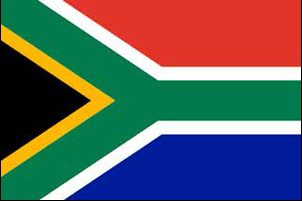 When the democratic government came into power in 1994, one of its biggest challenges was to unite the country and create a shared sense of identity. To help achieve this government introduced a range of national symbols, each symbolic of the country’s diverse cultures.
When the democratic government came into power in 1994, one of its biggest challenges was to unite the country and create a shared sense of identity. To help achieve this government introduced a range of national symbols, each symbolic of the country’s diverse cultures.
The South African flag
South Africa boasts one of the most colourful and unique flags in the world. The new national flag was first unveiled on 27 April 1994. Its design and combination of bright colours depicts the blend of a rainbow nation. The central ‘V’ shape also shows the coming together of different people and elements in South African society to take on the road ahead in unity.
The National Anthem
South Africa is the only country in the world to have a national anthem sung in five different languages - isiXhosa, isiZulu, Sesotho, Afrikaans and English. In 1997 the late former President Nelson Mandela decided that the country would have two official anthems - Nkosi Sikelel’ iAfrika (Lord bless Africa) and Die Stem van Suid-Afrika (the call of South Africa) - combined into one.
Nkosi Sikilel’ iAfrika was composed in 1897 by Methodist mission teacher Enoch Sontonga. It was first sung as a church hymn. Die Stem was written by local author Cornelis Jacobus Langenhoven in 1918.
The National Coat of Arms
A national Coat of Arms is a state’s emblem, which is used as a government symbol. It is also used on documents approved by the President and Government of South Africa, like birth certificates and identity documents. Launched on Freedom Day on 27 April 2000, the Coat of Arms design includes elephant tusks, a shield, spear, knobkerrie, human Khoisan figures, a bird, protea and the rising sun. The human Khoisan rock art figures symbolise a greeting in unity, with the motto “!KE E: / XARRA // KE”, which translated from the Khoisan language means diverse people unite.
National animal
The country’s national animal is the springbok. The springbok is known for withstanding various types of weather especially in the dry, open plains found across the country. They move in small herds during winter but can be found in large herds during the warmer seasons. The South African rugby team is also named after the national animal and is known as the Springboks.
National bird
South Africa is home to a variety of indigenous and exotic birds. One that stands apart, at almost a metre high, is the blue crane. These birds, which are light blue-grey in colour, are commonly found in the Karoo and parts of KwaZulu-Natal. The blue crane has a distinctive rattling, high-pitched croak that can be heard from miles away. Today there are a number of restaurants, lodges and awards named after this beautiful bird.
National tree
South Africa’s national tree is the real yellowwood tree, found along Table Mountain and the ravines of Drakensberg for more than a 100 million years. They grow up to 40 metres high and are up to three metres wide.
National fish
South Africa’s national fish is the galjoen. It is only found along the coast from Namibia to Durban. It lives in shallow water near the shore and is known to anglers as a game fighter. It is usually black but those that breed in sandy areas are silver-bronze.
National flower
A well-known symbol, the country’s national flower is the King Protea. It is the largest flower in the Protea family and is found in the Western Cape. The pink petals make the flower an important part of the Cape Floral Region - a World Heritage site. The country’s cricket team is named after the national flower and is known as the Proteas.
National Orders
The national orders are the highest awards that a country and its President bestows on deserving citizens who make remarkable discoveries and change the country for the better. South Africa has six national orders:
- The Order of the Mapungubwe, which is awarded for excellence and exceptional achievements that have had an international impact.
- The Order of the Baobab, which is awarded for distinguished service in the fields of business and the economy, science, medicine and technological innovation and community service.
- The Order of the Companions of OR Tambo, which is awarded to heads of state and other dignitaries for promoting peace, cooperation and friendship towards South Africa.
- The Order of Luthuli, which is awarded to South Africans who have made a meaningful contribution to the struggle for democracy, human rights, nation-building, justice, peace and conflict resolution. It symbolises the vision of the late Chief Albert Luthuli - the legendary liberation struggle leader and the first African recipient of the Nobel Peace Prize in 1961.
- The Order of Ikhamanga, which is awarded to South African citizens who have excelled in the fields of arts, culture, literature, music, journalism and sport.
- The Mendi Decoration for Bravery, which is awarded to South African citizens who have performed extraordinary acts of bravery.
Source : Department of Arts and Culture.
SA reflects on unity
SA reflects on unity sadminSouth Africa has made a lot of progress since 1994, with many citizens agreeing that the country is a much better place.
South Africans from different walks of life shared their views on how the country has fared when it comes to nation building.

Shane Westlake, Durban
We have come a long way since 1994, but a lot still needs to be done. The 2010 FIFA World Cup and sport does unite us but racism, gender inequality, violence and crime are prevalent in our society.
Tina Fela, Hillbrow
The current government has made great strides and many people's lives (including mine) have changed. However, many citizens still don't acknowledge the legacy of apartheid, which did not end in 1994. People are still dealing with those generational issues that can hinder a person's development.
Priscilla Ndula, Tembisa
In the past my mother would tell me stories about how badly she was treated and poorly paid by her employers just because she was a black woman. Today, I am treated as just an employee at work and not judged for being a woman or black.
Seugnet van Zyl, Pretoria
We are closer as a nation, just look at the legacy left by the 2010 FIFA World Cup. People from all walks of life are now able to interact and live in harmony. That was unheard of in the past and it's the reason why we are called the rainbow nation.
Cheryl Reddy, Randburg
As the country celebrates 20 years of democracy, we are far from being a united nation. Racism is rife in our country and I have experienced it personally. It saddens me that while we have come so far, society still passes judgment based on skin colour.
Sandra Matsheke, Rustenburg
I travel a lot because of my job and I have never come across a country so proud of its culture. South Africa is my home, a place where I am treated like I belong. Yes, there are issues related to inequalities but we have overcome a lot and we will continue to do so.
SA shows its sporting muscle
SA shows its sporting muscle sadminFor a long time, South African sport was isolated from international events because of the country’s apartheid regime.
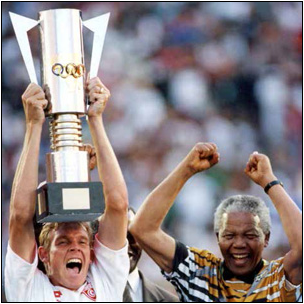 The country was absent from international competition for 32 years as a result of international sporting sanctions imposed because of South Africa’s apartheid policy.
The country was absent from international competition for 32 years as a result of international sporting sanctions imposed because of South Africa’s apartheid policy.
On the home front, under apartheid blacks did not have equal access to competitive or recreational sports opportunities at school or community levels, according to the Twenty Year Review released by the Presidency.
“There was little or no investment in sports infrastructure, equipment, attire, development, talent identification and/or activities for previously disadvantaged population groups,” the review notes.
South African teams and athletes started competing globally in 1992 after the country’s white electorate voted in a referendum in favour of a negotiated settlement on the issue of apartheid and the country was re-admitted to the international sports arena.
Since 1994, sport has been a unifying force in South Africa.
Sporting institutions such as the South African Council on Sport, the South African Non- Racial Olympic Committee and the National Sports Council were consolidated by building a democratic and unified sports system.
From being an outsider, South Africa is now an affiliate of the Supreme Council of Sport (SCSA, Zone VI) and also participates in various international sport organisations and events, such as the Commonwealth Games, Olympic Games, Paralympic Games, World Games, World Anti-doping Agency, International Anti-doping Arrangement, FIFA tournaments and continental competitions.
According to the review, from 1994 to 2005, Sport and Recreation South Africa built 744 sport and recreation facilities throughout the country. South Africa has also successfully hosted a number of key international sporting events, most notably the Rugby World Cup in 1995, the African Cup of Nations in 1996 and the 2010 FIFA World Cup.
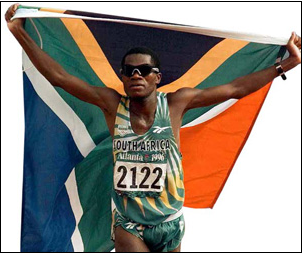 “These events strengthened the glue that keeps this country together by fostering an overarching national identity as well as a spirit of camaraderie. They also contributed significantly towards developing South Africa as a tourist destination,” the review adds.
“These events strengthened the glue that keeps this country together by fostering an overarching national identity as well as a spirit of camaraderie. They also contributed significantly towards developing South Africa as a tourist destination,” the review adds.
Since the advent of democracy, the performance of South Africa’s national teams has been on the rise with the Springboks winning the Rugby World Cup in front of the home crowd at a packed Ellis Park Stadium in 1995. The Springboks defeated New Zealand 15 – 12 in the final.
The 1995 Rugby World Cup played a significant role in healing a divided nation. It was also the first world cup in which all matches were played in one country for the duration of the tournament.
The 1995 Rugby World Cup was the first major sporting event to take place in South Africa after the end of apartheid. It was also the first world cup in which South Africa was allowed to compete - the International Rugby Football Board (IRFB, now the International Rugby Board) had only re-admitted South Africa to international rugby in 1992, following negotiations to end apartheid.
At the game, the late former President Nelson Mandela walked onto the field to congratulate the team, a moment that South Africans remember with pride.
“In the late former President Nelson Mandela, the country had a leader acceptable to almost all groups in society and deeply respected across racial and class boundaries. In this regard, President Mandela was himself a key part of the new national identity,” reads the review.
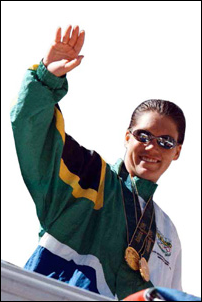 The following year, Bafana Bafana emulated their rugby counterparts when they captured the African Cup of Nations. The 1996 African Cup of Nations showpiece was held for the 20th time and for the first time on South African soil.
The following year, Bafana Bafana emulated their rugby counterparts when they captured the African Cup of Nations. The 1996 African Cup of Nations showpiece was held for the 20th time and for the first time on South African soil.
Also in 1996, at the Atlanta Olympic Games, Penny Heyns won both the 100m and 200m breaststroke events.
It was the first time democratic South Africa participated in the Olympics and Heyns’ performance in the pool made her the country’s first post-apartheid Olympic gold medalist.
On the track, Josia Thugwane also did the country proud by winning a gold medal at his first attempt. Thugwane won the gold medal in the marathon becoming the first black athlete to earn an Olympic gold for South Africa.
Two years after successfully winning the African Cup of Nations on home soil, the national football team also qualified for the FIFA World Cup in 1998, held in France. Though the team was kicked out in the first round, qualifying for the tournament for the first time was a huge step in the right direction.
Sport has been used as a tool to heal a nation divided as a result of apartheid. This was evident during the 2010 FIFA World Cup, which was held on the African continent for the first time. South Africans of all races rallied behind the national team for the duration of the tournament.
The review acknowledges the important role that sport has played in the uniting South Africans.
“Sports interaction has contributed towards increased interaction across race and class,” the review notes.
